Connecting Communities
AFTERMATH





AFTERMATH




Whether they are designing community projects that join neighborhoods together or mentoring the next generation of students and young professionals, Florida’s engineers are setting the state up to thrive for years to come.

Welcome to the Fall 2024 issue of Engineering Florida, where our theme, "Connecting Communities," explores the critical role engineers play in bridging divides—both literally and metaphorically—across our state. As Florida continues to grow and evolve, the work of engineers is more essential than ever in creating connections that enhance the quality of life for all Floridians.
We have captured engineering stories from around the state now for seven issues, and we are thankful to have been recognized this summer by the Society for Marketing Professional Services (SMPS) with a National Award of Merit for our work. Thank you for reading and helping make Engineering Florida a success.
This issue features an in-depth look at the Urban Search and Rescue (US&R) program, a vital component of our state's disaster response efforts. Engineers on US&R teams play a pivotal role in ensuring the safety and recovery of our communities following natural disasters. Their expertise in assessing structural integrity and executing rapid response strategies is crucial in saving lives and helping communities rebuild stronger and more resilient.
We also spotlight the Reconnecting Communities Pilot Program, a groundbreaking initiative aimed at healing the social and economic fabric of neighborhoods divided by past infrastructure projects.
Today, engineers are leading efforts to reverse this damage by designing urban environments around Florida that promote inclusivity and connectivity.
These projects go beyond infrastructure—they’re about healing and reconnecting communities that have been divided for too long.
The Brightline Rail project is another significant example of how engineering is connecting communities across Florida. This high-speed rail service is transforming travel between major cities, offering a sustainable alternative to road travel and alleviating highway congestion.
The expansion of Brightline is not just about transportation; it’s about creating new economic opportunities and fostering greater connectivity across the state. In addition to Brightline, we’ll also look at the Emerald Trail project in Northeast Florida in our Market Spotlight.
As you read through this issue, I hope you feel as inspired as I do by the incredible work being done by engineers across Florida. Whether it's through disaster response, innovative infrastructure projects, or reimagining our urban cores, engineers are at the forefront of efforts to connect and uplift our communities.
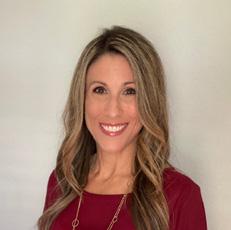
Stacey Butler Director of Marketing & Communications Florida Engineering Society (FES), ACEC Florida
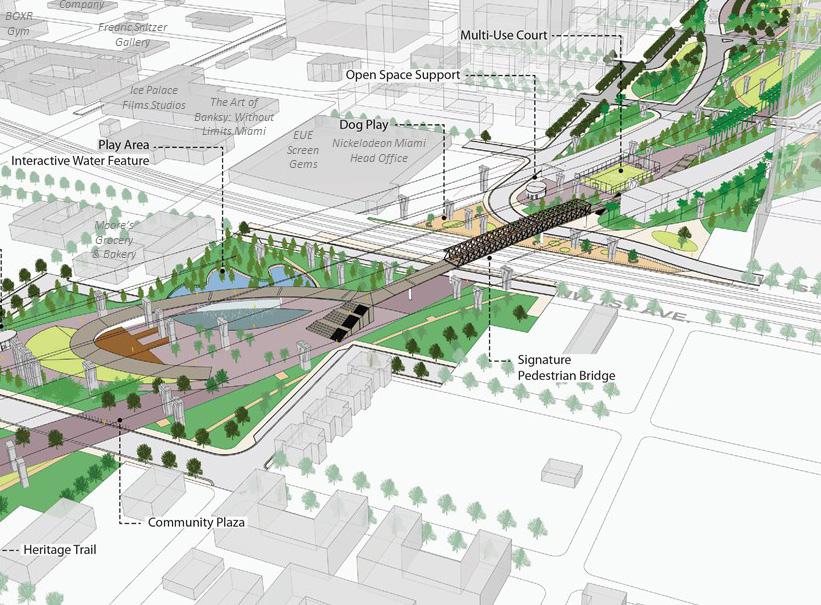


Editor-in-Chief Stacey Butler
Managing Editor Joe VanHoose
Layout Editor Claire Jordan
Creative Direction Hannah Groseclose
Contributors
Thomas Ehlers
Lindsey Ranayhossaini
Johnathan McGinty
Lauren Heighton
Ad Director
Meghan Shiner
Katie Batill-Bigler, CPSM Patel, Greene & Associates | SMPS
Stacey Butler, Director of Marketing & Communications FES | ACEC Florida
John Constantinide, PE Director and Regional Chair, ASHRAE Region XII
David Cowan, Jr, PE, ENV SP Chen Moore and Associates | FES
Kelly Cranford, PE, ENV SP KEITH | FES
Charles W. Davis, Jr, Ph.D. Associate Professor at Embry-Riddle Aeronautical University | FES President
Allen Douglas, Executive Director FES | ACEC Florida
David Fusco, PE, FRSE, LEED AP Thornton Tomasetti | FSEA
Sunserea Gates, PE VHB | ASHE
Andy Lauzier, PE HDR | ACEC Florida President
Scott Martin, PE, LEED AP, DBIA Walter P. Moore | ACEC Florida
Jennifer Nix McGerald, CPSM RS&H | ACEC Florida
Edie Ousley, President Yellow Finch Strategies
Cherie Pinsky, Chief Operating Officer FES | ACEC Florida
Adam Schildmeier, PE WGI | FES
Ann Schiola, CPSM CIP-II RS&H | ACEC Florida
Meghan Shiner, Communications Coordinator FES | ACEC Florida
Jignesh Vyas, PE Ardurra | ASCE
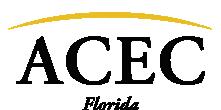





FL-ASCE BROWARD
Annual Installation Dinner & Awards Ceremony HILLSBOROUGH BEACH
ASHRAE
ASHRAE Central Florida Chapter Clay Shoot SUMTERVILLE
ASCE ASCE Convention TAMPA FLUG 2024 FLUG Conference COCOA BEACH ACEC ACEC Fall Conference NEW ORLEANS, LA.

FL-ASCE 3rd Annual Student Development Conference ORLANDO 03 01 04 13 0609 0811 25 FES & ASHE
FES Tampa Chapter & ASHE Tampa Bay Inaugural Golf Tournament
FES Board of Directors Meeting ACEC Florida Board of Directors Meeting
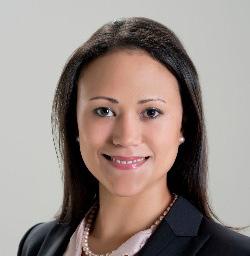
EVeronica Bayó Clifford, Esq.
Veronica Bayó Clifford, Esq. is of counsel for Grossman, Furlow & Bayó, LLC in Tallahassee.
ngineers are often seen as the backbone of technological and infrastructural advancements. However, some of the most rewarding work an engineer can perform is not in their day-to-day professional duties, but rather through volunteer work.
Many engineers are actively involved in giving back to their communities, leveraging their skills and knowledge to create a positive impact. Whether it is through educational outreach, pro bono engineering services, sustainable development projects, disaster relief and recovery or community engagement and advocacy, their contributions extend far beyond the confines of their professional duties.
It is indisputable that this is worthy and essential work that benefits our communities in countless ways. Indeed, in a state with some of the most extreme weather in the country, the services engineers provide have been, and continue to be, the difference between life and death.
official duties and as a reasonably prudent person would under similar circumstances. If a volunteer is not held liable, the nonprofit organization they were working for may still be liable for damages to the same extent as if the volunteer protection did not exist.
The question then becomes, does the Florida Volunteer Protection Act apply to the design work of professional engineers who are volunteering their services? For that answer, we need to look at the Florida Engineering Liability Protection Act of 2021.
This Act recognizes the importance of qualified professionals in disaster response. Section 768.382, F.S. provides liability protection for engineers, architects and other professionals who assist during natural disasters.
This law grants immunity from civil liability to these licensed professionals who volunteer their services during emergencies. Protection extends to actions taken in good faith while assisting with disasterrelated activities.
The law covers a wide range of activities, including damage assessment, structural inspections and safety evaluations.

Nevertheless, engineers should always be aware of the potential liabilities they face when providing such services and make a point to know the ways in which they can best mitigate their risk.
In Florida, individuals who volunteer their services are generally protected under the Florida Volunteer Protection Act. This law, established in section 768.1355 of the Florida Statutes, serves as a general volunteer immunity statute, providing protection from civil liability for acts or omissions resulting in personal injury or property damage by individuals who perform volunteer services for nonprofit organizations.
Volunteers are not liable for any act or omission that results in personal injury or property damage if they were acting in good faith within the scope of their
The limitation on liability applies to an act or omission of an engineer, architect or structures specialist in the performance of his or her services on a volunteer basis, when performed while under the direction of, or in connection with, a community emergency response team, a local emergency management agency, the Division of Emergency Management, or the Federal Emergency Management Agency.
However, the limitation on liability does not apply to an act or omission constituting gross negligence or willful misconduct. The limitation on liability only applies during a declared national, state, or local emergency, or within 90 days after the end of such an emergency.
The fact that the legislature created a law specifically geared towards addressing volunteer professional work by engineers and architects in emergency situations can lead us to an important conclusion.
Namely, that the Florida Volunteer Protection Act does not offer protection to engineers engaged in the practice of engineering on a voluntary basis.

So how do engineers mitigate their risks while still providing these essential volunteer services?
Engineers must understand that there is only one standard of practice, whether the engineer is being paid or serving as a volunteer. There have been cases where engineers were disciplined for lack of detail in design documents being prepared as a favor to a neighbor or to their church. Corners were cut and detail was lacking because the engineer thought that the fact they were providing these plans as a favor somehow reduced the required level of detail.
That is simply not the case. Engineers providing volunteer professional services are expected to adhere to the same professional standards as they would in paid work. This means they must apply the level of skill, care and diligence that is typical for their profession.

If a design error occurs due to negligence or failure to meet these standards, the engineer could be held liable. While the Florida Engineering Liability Protection Act provides some immunity for volunteers in emergency situations, that immunity is very limited and does not cover gross negligence or willful misconduct. If a design error is deemed to be a result of such behavior, the engineer could still face liability.
As a practical matter, engineers should confirm that their professional liability insurance covers volunteer work. They should also find out if the entity that they are providing volunteer services for has available insurance coverage. Engineers should request that clear written agreements be in place when volunteering their engineering services. These agreements should outline the scope of work, responsibilities and any limitations on liability. This can help manage expectations and provide some legal protection.
Isn’t this what engineers normally do when engaging in regular non-volunteer duties?
Yes. And that is the point. The fact that an engineer is providing volunteer engineering services should not change the professional standards to which they hold themselves in their private practice. This includes following industry standards, codes and regulations.
Documentation should not be ignored. Having the requisite design calculations, decisions and communications within your records can be crucial if any issues arise later. Nor should there be any laxity in ensuring that all designs and plans are reviewed and approved by relevant authorities or experienced professionals.
By taking these steps, engineers can effectively manage and mitigate liability risks while making meaningful contributions to their communities.


Jeff Littlejohn, P.E., is a senior policy advisor for Adams and Reese. He serves FES and ACEC Florida members with water, energy and environmental policy support.
The Florida engineering industry has long been an instrumental force in guiding the state's legislative efforts on water policy. This role was exemplified in the recent legislative panel on water policy, which took place at this year’s FES/ACEC Florida Annual Conference in Miami.
The panel was hosted by the Water Resources Committee (WRC), where state legislators and engineering professionals came together to discuss key issues and solutions. It featured two prominent Florida Senators, Jennifer Bradley and Jonathan Martin, alongside Environmental Committee and WRC chairs and seasoned engineers Michael DelCharco, P.E., and Brent Whitfield, P.E.
Their collective expertise painted a vivid picture of how engineers and legislators can collaborate to address Florida’s water challenges, ensuring the industry continues to be a positive influence on the legislative process.
The panel was part of the WRC's ongoing effort to engage legislators on water policy and funding, providing an opportunity for Florida's engineers to offer their expertise directly to policymakers. The panel discussion was structured around three central topics, with contributions from both legislators and committee leaders. This open dialogue format encouraged collaboration and audience participation, ensuring that a wide array of perspectives informed the conversation.
One of the most significant takeaways from the panel was the legislators' support for a new Florida Water Work Plan, modeled after the Florida Department of Transportation's (FDOT) successful five-year work plan.
Both Senators Bradley and Martin endorsed the idea, recognizing that Florida's water infrastructure, much like its transportation system, requires long-term strategic planning, prioritization and funding to ensure resiliency and sustainability.
Florida’s water resources are under increasing stress from population growth, climate change and emerging contaminants such as PFAS. The WRC panel highlighted the importance of technical expertise in navigating these challenges.

DelCharco, who has been involved with the WRC for over 24 years and leads Taylor Engineering's Coastal Strategies group, emphasized the need for coastal and riverine flood resiliency. His work focuses on moving communities from planning to action, an approach that is vital in the face of rising sea levels and more frequent flooding events. Similarly, Whitfield, with more than two decades of experience designing water infrastructure solutions, spoke about the critical role that modeling studies play in planning for future water resource needs. His work on sea level rise in Miami-Dade County for the South Florida Water Management District (SFWMD) and the U.S. Army Corps of Engineers (USACE) is a prime example of how engineering research can inform and shape public policy.
The panel also discussed the impact of state legislation, such as Senate Bill 712 (the Clean Waterways Act), on Florida’s water resources. With Florida’s population continuing to grow, engineers play an increasingly important role in crafting the solutions needed to meet future water demands while preserving natural resources.
The concept of a State Water Work Plan gained significant traction during the panel. Such a plan would help prioritize and fund critical water infrastructure projects, much like the FDOT’s 5-year plan does for transportation projects. This would allow for better allocation of resources and provide a roadmap for addressing both existing infrastructure needs and future challenges such as climate change, pollution and increased demand.
House Bill 53, passed in 2021, required the collection of data from local governments on their water infrastructure needs. However, the panelists raised questions about how this data is being used and whether it is comprehensive enough to address the state’s current and future water challenges.
The panel underscored the need for engineers to continue to work closely with policymakers to ensure that data collection efforts are informed by real-world technical knowledge.
One of the goals of the WRC panel was to establish the committee as a resource for technical support during the formulation of policy. As engineers, DelCharco, Whitfield and Littlejohn have consistently contributed their expertise to shaping Florida’s water policy. Their technical understanding of water systems is critical for informing legislation that not only addresses immediate needs but also anticipates future challenges.
Engineers' involvement in the legislative process ensures that Florida’s water policy is both pragmatic and forwardthinking, providing a solid foundation for the state's long-term water management strategy. The endorsement of a Florida Water Work Plan is a prime example of how this partnership can lead to innovative solutions that will benefit the state for generations to come.

As employee owners, we’re driven to care.
We work hard every day to create a more connected future where everyone can thrive.
We don’t just get it done – we get it done right.
Start your exceptional journey today. Full-service A/E/C solutions at rsandh.com.
By Joe VanHoose, Managing Editor

In July, the first of six steel arches was completed over what will ultimately become the signature bridge to Miami’s Interstate 395/State Road 836/Interstate 95 project.
A partnership between the Florida Department of Transportation (FDOT) and the Greater Miami Expressway Agency (GMX), the $840 million transformation of these arteries to Downtown Miami will enhance safety for drivers entering and exiting SR 836 and I-95 at the Midtown Interchange and create a new signature structure in the city’s skyline.
But the goals and scope of the project go much farther than just what motorists will experience. Safety will also be enhanced for pedestrians under the new I-395 bridges with creation of a contiguous trail from Northwest Third Avenue to Biscayne Boulevard, enhanced crosswalks and new bike lanes. The trail and underdeck
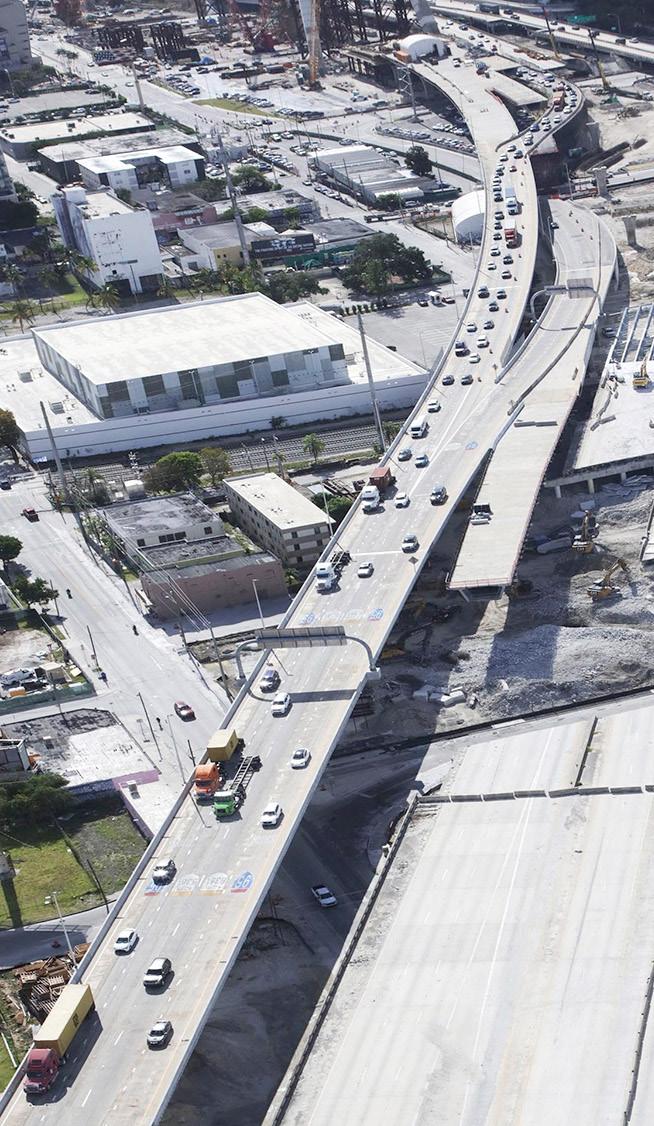


park will reconnect communities in Downtown Miami that have long been segmented apart by the highway infrastructure.
“It’s going to be spectacular,” said Andrew Frey, director of Department of Real Estate and Asset Management (DREAM) for the the City of Miami. “The elevated highway is triple the height of the current elevated
“It’s going to be spectacular...”
— ANDREW FREY Director of DREAM for the the City of Miami
Renderings of Miami’s new Underdeck Park and Heritage Trail at the base of the I-395 Signature Bridge. The project is scheduled to be completed by 2027.
highway, so that is going to let in a lot more light and air, making a lot more pleasant space. The fact that it’s suspended with far fewer columns underneath means more unobstructed space to create a great community greenspace.”
The Miami Underdeck project is one of a handful of projects in Florida that have been awarded grant funding from the U.S. Department of Transportation’s

Reconnecting Communities Pilot (RCP) grant program. The RCP Program focuses on improving access to daily needs such as jobs, education, healthcare, food, nature and recreation, and fostering equitable development and restoration.
In 2023, the City of Miami received more than $60 million in RCP grant funding for the Underdeck. Since the program’s launch in 2022, community projects from Jacksonville to Tampa to Miami have been awarded a total of hundreds of millions of dollars.
Officially known as the “Connecting Miami I-395 Underdeck and Heritage Trail,” the Underdeck park will serve as a public gathering place that weaves below the elevated I-395 highway viaducts. A 33-acre urban open
"Success could take the form of not only economic impact but also celebration and honoring of history, and being honest about some of the things that the community suffered..."
— ANDREW FREY Director of DREAM for the the City of Miami
space and streetscapes will reunite the urban fabric of Overtown, a historically Black neighborhood that was disconnected during highway construction in the 1960s. The mile-long Heritage Trail will connect neighborhoods across active rail tracks, linking Overtown to Biscayne Bay.
The Underdeck will provide a safe place for walkers and joggers, bikers and scooters, encouraging non-vehicular transportation options, while improving quality of life, economic vitality and social equity for all through the creation of an environmentally sustainable and resilient urban landscape.

FDOT is working with the Archer Western-de Moya joint venture (JV) to reconstruct the I-395 viaducts, including the construction of the iconic “fountain” bridge structure. Meanwhile, the City is gathering community input on the exact features the Underdeck will have. The same JV will construct the Underdeck park in conjunction with finishing construction on the roadways above.
HDR is the engineer of record for the bridge and the I-395 roadways and also helped develop the vision for the Heritage Trail. The City of Miami is working with its landscape design partner Hargreaves Jones to fill in the details, gathering community input on the remaining
design decisions.
“We are collaborating with FDOT and their JV on detailing the consensus plan design that was agreed to in early 2022,” Frey said. “So now our work is picking that back up and focusing on the work to detail that and engineer it and get it to construction drawings.”
Should all go according to plan, the Underdeck project would wrap up alongside the bridge work in 2027. When complete, success will be judged by a few different criteria, Frey said.

“(Success) could take the form of not only economic impact but also celebration and honoring of history, and being honest about some of the things that the community suffered through signage and other features – we’re not looking away from that,” Frey said. “In addition to the effect on the neighborhood, we hope it’s an amenity for all the residents of the City of Miami and a nice destination for those who visit us from across the world.”
Thirty miles north in Fort Lauderdale, the Broward County Metropolitan Planning Organization secured a $1.5 million USDOT Reconnecting Communities grant to move forward with Connect FTL, a project that will improve five highwayrail grade crossings of roadways with the Florida East Coast Railroad (FEC) by tunneling under the railroad to improve pedestrian and cycling connections between the east and west sides of the city.
The new bridges for I-395 are triple the height of the former elevated highway, which will allow more light into the Underdeck park.

The FEC separates poorer, historically Black neighborhoods of Fort Lauderdale from the wealthier areas in the eastern part of the city. In addition, most services and facilities such as hospitals, schools, grocery stores, parks and entertainment venues, are on the east side.
The at-grade crossings create dangerous conditions for travelers, pedestrians and cyclists as the crossings lack sidewalks and bike lanes. The tunnels will add dedicated sidewalks and bike lanes at each intersection to address current safety and access needs, and in preparation of the opening of new commuter rail stations at two of the intersections.
Expected walk and bike accessibility improvements are expected to reach 12,000 and 100,000 residents, respectively.
Also in South Florida, the Miccosukee Tribe was awarded $784,668 from the USDOT to enhance connectivity, mobility, safety, economic development and equity within the Tribe's community, including two bridges over the Old Tamiami Trail.
This project aims to enhance access by creating safe routes for pedestrians and cyclists while still accommodating vehicular access, ensuring a comprehensive approach to accessibility. The Miccosukee Tribe's community primarily relies on Old Tamiami Trail for their daily activities.

In Duval County, Jacksonville Transportation Authority and Groundwork Jacksonville are moving forward with the Emerald Trail after receiving a $147 million Reconnecting Communities grant. The project will fund design and construction of 15 miles of a 30-mile trail and linear park system, connecting 14 neighborhoods to downtown. [Editor's Note: Read more about the Emerald Trail project in our Market Spotlight on page 34.]
In its grant application for “UNITE: Ashley Drive,” the City of Tampa shared the direct feedback of these residents and many others in neighborhoods that have never recovered socially or economically from the bisection of North Downtown. For instance, the poverty rate in Ashley Drive’s census tract is 23%, 10 points higher than the statewide average.

It’s all part of a bigger plan for Downtown Tampa, which will ultimately have its Green Spine pedestrian and cyclist path run from North Hyde Park to Ybor City, connecting river walks on either side.
A recipient of $5.35 million in RCP grants, the UNITE project will lower Ashley Drive’s interchange ramp to street level and introduce new roadway connections at Harrison and Royal Streets, reconnecting Downtown Tampa’s historic street grid. Additionally, the project will provide direct pedestrian and bike routes to the Hillsborough River and create new park spaces and affordable housing options.
Still in the early stages, the City will soon hire a designer and contractors for the Ashley Drive project with hopes of having the three new downtown blocks recreated and ready in about five years. HNTB has served as a consultant partner and provided cost estimates for the project, and Kittelson & Associates helped with the grant process and community engagement. Kittelson also has served as the primary consultant in developing Tampa’s mobility plan,

MOVES (Mobility, Opportunity, Vision, Equity, Safety).
“This project wasn’t conceived in isolation; it’s part of a whole picture and slew of new projects,” said City of Tampa Director of Mobility Vik Bhide.
“The MOVES plan established some goals for us, and this project reflects those goals significantly.”
The Ashley Drive project is part of a broader effort to reduce
and cycle tracks is that we want to make sure this area is accessible to affordable means of transportation,” Bhide said. “You won’t need a car to get around between Ybor, Downtown, the Channelside District and the Highlands, and now even West Tampa.”
The need to transform Ashley Drive was first identified in 2011 as part of the City of Tampa’s InVision City Center Plan, which highlighted the corridor as a barrier that prevented access to the riverfront. FDOT studied the traffic trade-offs in 2018 and looked for ways to integrate the project into a planned interstate project.
“The crux of this project or the principle we are working off of is twofold: one is our mobility plan, which came later, and the InVision plan, which really imagined the river as the center of the city and building out from there,” Bhide said. “This project was part of that, and the MOVES plan added the elements of equity and reconnecting the community.”

Aftertransportation costs in Tampa, where it accounts for 23% of area median income. By connecting east downtown to west downtown, Bhide said, connectivity and continuity on either side of the river will result in better access, safety improvements and walkability – all of which will be good for economic development, he added.
“What we are very aware of is equity, and one reason we are doing this and coordinating it with a streetcar extension
The application process to receive 2024 RCP funding is open through Sept. 30, with up to $607 million available for planning, capital construction and technical assistance.
Beyond transportation and public space projects, the state has made gains in helping Floridians in rural communities connect easier to the web.
In February, the State of Florida awarded nearly $223 million to expand broadband internet access in the state, including small and rural communities. This funding includes $135 million in state funding through the Broadband Opportunity Program and $86 million in federal funds through the Multipurpose Community Facilities Program.
Awards through the Broadband Opportunity Program will support 54 projects in 33 Florida counties for broadband internet expansion that will provide internet to over 27,000 unserved residential, educational, agricultural, business and community locations.
Awards through the Multipurpose Community Facilities Program will support 29 community infrastructure projects including health clinics, schools and workforce development programs providing internet to residents across 18 counties.

ACEC Florida, in conjunction with the Florida Engineering Society, administers the Florida Engineering Leadership Institute (FELI), a beacon of excellence, education and community engagement in the engineering profession.
Designed to transition engineering professionals into leaders within their communities, workplaces and the broader society, FELI offers a unique opportunity for engineers to develop and hone their leadership skills while giving back to the community.
The program’s structure is intentionally crafted to be immersive and hands-on. Over the course of 10 months, participants engage in a series of 6 sessions held in key cities across Florida, each focused on a different aspect of leadership. The comprehensive curriculum ensures that participants learn about leadership in theory and practice it in real-world scenarios.
Recognizing that engineers possess not only technical expertise but also the potential to make a significant impact on society, FELI’s creators developed the program to enhance leadership capabilities and provide a clear pathway for engineers to serve both their profession and their communities.
Each FELI Class engages in community projects as part of their leadership training to not only enhance their own careers but also contribute to the betterment of society. This instills a sense of responsibility and a commitment to giving back, ensuring that the leadership skills developed through FELI are used to benefit the broader community.
Ongoing initiatives serve as a shining example of how engineers can lead by example, giving back to the communities they help build and sustain. Most recently, the FELI Class of 2024:
• Promoted the American Association of State Highway and Transportation Officials (AASHTO) STEM Outreach Solutions program across the state. This included partnering with the Florida Department of Transportation (FDOT) to purchase
100 STEM Outreach Boxes valued at $100,000. These “boxes” are hands-on educational modules geared towards introducing students to the diverse array of careers in transportation and infrastructure. This partnership is set to continue over the next five years.
• Raised over $140,000 and created an endowed fund to ensure teachers can attend training and refill box materials as required.
• Organized and participated in a Central Florida teacher training session to explain how the boxes can be incorporated into their curriculum.
• Attended Florida Construction Career Days to identify teachers across Florida interested in teaching STEM in the classroom.
• Fed the body and mind of the community by volunteering at food banks in Tallahassee, Orlando, Jacksonville, Miami and Tampa.
• Funded scholarships for public engineering employees to attend future FELI programs.
The FELI Class of 2023 raised $100,000 in contributions to support the Class’s chosen charitable programs –helping Hurricane Ian ravaged communities. The 2022 Class adopted two charitable programs – Sleep In Heavenly Peace, which helps ensure no child sleeps on the floor, and Feeding Florida, the food bank network of Florida – and raised $66,000 for them, and built about 100 bunk-beds.
FELI is more than just a professional development program; it is a catalyst for change. Through its focus on leadership, community service and networking, FELI is shaping the future of Florida’s communities by empowering engineers to take on leadership roles and make a positive impact.
As engineers transition from technical professionals to community leaders, they carry the lessons learned and the connections made through FELI. This ongoing commitment to leadership and service ensures that the benefits of FELI extend far beyond the individual participants, reaching into the heart of Florida’s communities and contributing to a brighter future for all.
Another way engineers give back is through philanthropic efforts in their local communities. ACEC Florida President Andy Lauzier is also a Senior Vice President at HDR, whose foundation provides grants throughout the year to local organizations making a difference in the communities where we work and live.
One such program is the All-Kids Bike program, a national movement led by the Strider Education Foundation to place learn-to-ride programs into PE classes at targeted public schools for free. The HDR Foundation just awarded a $324,000 Impact Grant to fund the successful learn-to-ride bike program at 36 schools during the 2024-2025 school year. Since 2022, the HDR Foundation now has granted $834,000 to bring the program to more than 100 schools across the U.S.
In Florida, HDR’s Pensacola Office provided bikes to students at Warrenton and Sherwood Elementary. The Tampa office sponsored Dubar Elementary and


Woodson K-8, and the Tallahassee office sponsored Bond Elementary School.
Engineers have the power to change lives for the better, developing critical infrastructure projects that ensure people have everything from safe roads to clean water. We can make impacts here at home and across the globe.
Such is the goal for ACEC Florida Public Relations Committee Chair Rick V. Baldocchi, P.E., who works for ACEC Florida member firm AVCON and started Agua Viva Serves, Inc. (AVS), a non-profit organization dedicated to providing clean water and improving health conditions in Central America.
Working primarily in Costa Rica, AVS employs local staff in Costa Rica who are supported by mission teams from around the U.S. to install water wells and systems serving areas that do not have access to clean water. The group has completed over 100 wells and developed 7 full water systems that serve an estimated 1,200 residents in Costa Rica and Nicaragua.
For more information on AVS, please visit their website at avs.ngo or contact Rick at rvb9036@gmail.com.
The work done by engineers daily impacts the lives of many, and this organization is just one example of how ACEC Florida members are volunteering their time and resources to assist those in need.



By Lindsey Ranayhossaini, Staff Writer

Year after year, Orlando’s worldfamous theme parks attract millions of visitors to the Sunshine State. In fact, the city was named the No. 1 tourist destination in the United States in 2022, reporting 74 million visitors. With its beaches and vibrant nightlife scene, Miami follows close behind, volleying back and forth with Orlando for the top spot in numerous travel rankings.
Despite the high tourism traffic to these two Florida destinations, there has not been a straightforward transportation solution connecting the two, requiring visitors to rent cars for the four-hour drive or purchase airline tickets for an equally long trip when accounting for time at the airport.
“There’s a huge number of people traveling from Point A to Point B and no good transportation options,” said Andy Kunz, president of the U.S. High Speed Rail Association, a membership and trade association that advocates for expanding high speed rail travel in America.
To complicate matters, Florida has experienced explosive population growth in the wake of the COVID-19 pandemic. According to the U.S. Census Bureau, four of the nation’s top 10 metro areas for population growth from 2022 to 2023 were in Florida. The increase in new residents has further taxed state infrastructure and led to additional congestion on Florida’s roadways.
But Brightline, a provider of modern, intercity rail solutions, seeks to ease this congestion by offering consumers a third transportation option. The company’s Brightline Florida operation promises fast, reliable rail transportation between Miami and Orlando, with additional stations in Aventura, Fort Lauderdale, Boca Raton and West Palm Beach.
“What Brightline Florida has shown is that if you put a nice, new train service out there... passengers will respond in droves.”
— ANDY KUNZ President of the U.S. High Speed Rail Association
Using a route that partially runs on existing Florida East Coast Railway tracks, Brightline Florida’s East-West Connector was completed in September 2023. Though Brightline Florida began revenue operations in the state with its route from Fort Lauderdale to West Palm Beach in January 2018, the inception of the East-West Connector has fostered rapid growth in consumer demand for the rail service.
The route from Miami to Orlando operates with 16 trains per day, running at one-hour intervals. During the first quarter of 2024, ticket revenue totalled nearly $40 million, triple the amount of the year prior. In response to demand, Brightline has raised ticket prices and ordered additional trains to accommodate more passengers.
“What Brightline Florida has shown is that if you put a nice, new train service out there with multiple, convenient trains per hour and reliable and luxurious offerings, passengers will respond in droves,” Kunz said.
Before Brightline could begin operations in Florida, a herculean engineering effort was required to construct the rail line through a complicated corridor. Though Brightline utilized Florida East Coast Railway tracks to expedite the construction process for its line from Miami to Cocoa, there were numerous engineering problems to solve as the company established its new track between Cocoa and Orlando International Airport.
Brightline Florida partnered with engineering firm HNTB for assistance with program management and infrastructure design for the entirety of its 238-mile rail network, and HNTB served as engineer-of-record for the 38 route miles of track connecting Orlando and Cocoa. The design included 32 new bridges, grading, drainage, communications, signal layout and utility relocation.
“We’ve been the key office for Brightline since day one,” said George Gilhooley, office leader at HNTB. “We started out as their program manager, and that role grew continuously.”
One of the complications of building the track included working through the environmental permitting processes at the state and federal levels, Gillhooley said, as the new line passed through a lot of environmentally sensitive land where a variety of animals move.


“We did some pretty complex wildlife crossings out there to accommodate all the different species – everything from bears, to deer, to you name it cross out there,” Gilhooley said.
The solution was a shelving system constructed under the rail bridge with sections at the proper elevation for the species to cross through. Since many animals do not like to cross through water, the shelves were built above the waterline, allowing for a safe crossing under the bridge.
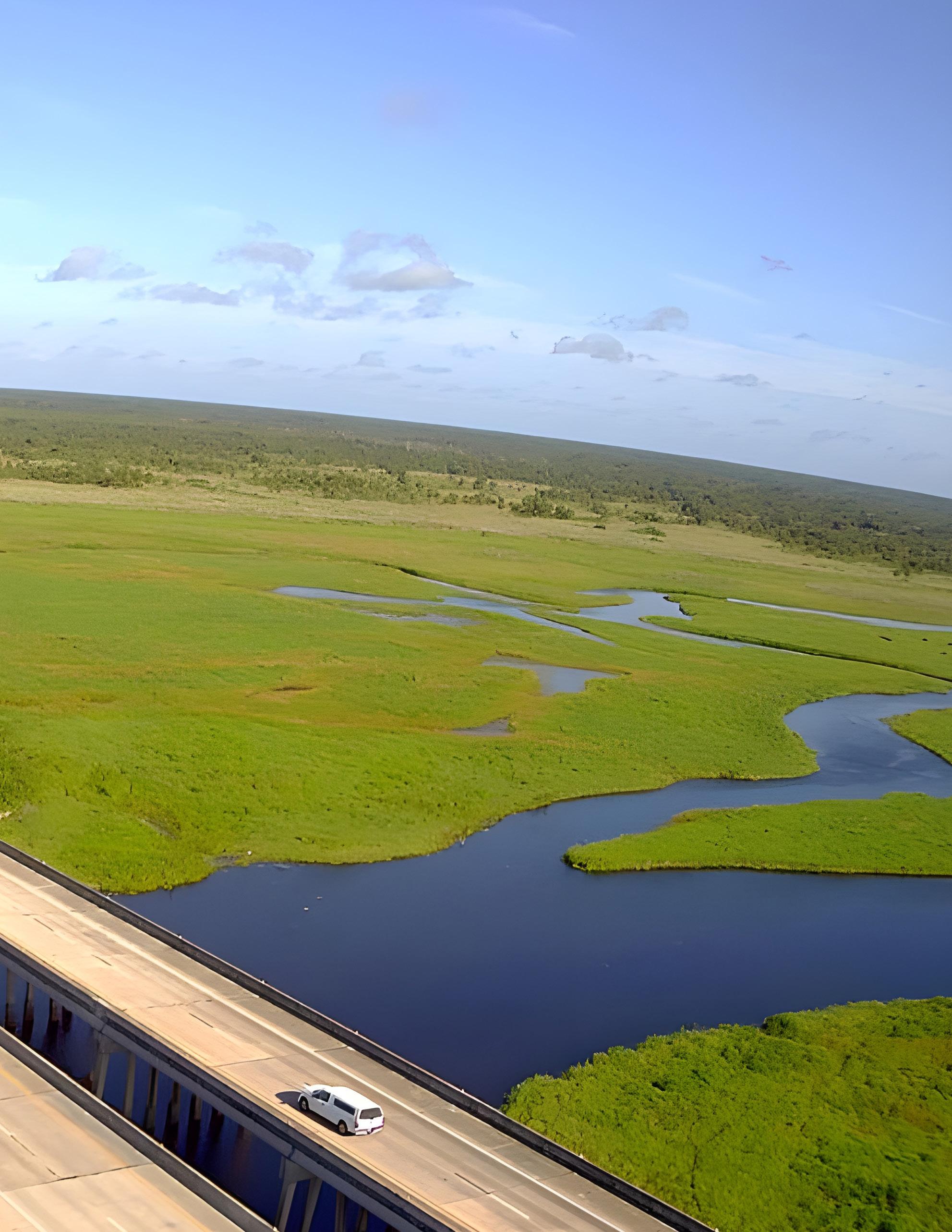
And though utilizing Florida East Coast Railway tracks for its line between Miami and Cocoa presented Brightline with advantages, those tracks still had to be upgraded to meet the demands of faster rail speeds.
“We did some pretty complex wildlife crossings out there to accommodate all the different species..."
— GEORGE GILHOOLEY Office leader at HNTB
Environmental permitting was not the only hurdle the design team faced. At Orlando International Airport, the design team had to design the alignment of the Brightline rail through complicated airport infrastructure, including working around critical utilities.
“There was a lot of work,” Gilhooley said.
“We double tracked or triple tracked a lot of it out there to have the capacity to run passenger rail in addition to the freight rail that was on (the line) already, but it was also upgrading the tracks to a higher speed.”
In addition, the railroad corridor contained features like fiber optic lines and utilities, all of which had to be relocated and kept in service throughout the construction process.
Perhaps the largest design challenge the engineering team navigated was the crossing at the Interstate 95 Interchange under State Road 528, where a bridge was needed to cross the highway in order to keep the railway at grade and allow Brightline’s trains to maintain speeds of 125 miles per hour. Conventional thinking would dictate the construction of a rail bridge over the highway, but HNTB devised an alternative solution.
“We had to cross the highway, but a rail bridge is about twice the cost of a highway bridge,” Gilhooley said. “We temporarily moved 528 and put in a tunnel so that the train stayed at grade. Then we just reconstructed 528 over that tunnel and were able to essentially keep the train running at a much higher speed.”


The SR 528 tunnel was constructed during a two-week span using the box-jacking method. Box-jacking allowed for concrete boxes to be precast outside the roadway and pushed under SR 528 using hydraulic jacks. Brightline employed a specialty contractor to facilitate this process, and this was the first instance in North America where the box-jacking method was used under a highway system under live traffic.
This design reduced five separate bridges to a single 574-foot-long bridge over the south side of I-95. This solution saved Brightline $25 million and more than six months of construction time.
Proponents of expanding high speed rail in the U.S. characterize high speed rail transportation as a “silver bullet” solution for many of the country's



“Congestion levels have reached epic proportions... Cars and aviation just can’t handle all of the people... that are trying to move around our country every day.”
— ANDY KUNZ President of the U.S. High Speed Rail Association

transportation woes, including highway congestion, rising oil costs and complications from climate change.
“Congestion levels have reached epic proportions, where it just makes it impossible to go anywhere quickly and efficiently,” Kunz said. “Cars and aviation just can’t handle all of the people in the big, modern nation that we are. We need this third option to really be able to move the numbers of people that are trying to move around our country every day.”
Detractors argue that America is too steeped in car culture to embrace high speed rail, and the cost of constructing a high speed rail system is simply too high. Brightline invested $5 billion in its rail line extension to Orlando, and though the company reported $40 million in ticket sales in the first quarter of 2024, it also recorded $116 million in losses.
This loss, according to Kunz, was because the company chose to write down some of its construction costs.
“That’s not in any way reflective of the system not being highly successful as an operation. Kunz said. “As an operation, it’s extremely profitable.”
Brightline officials did not respond to repeated requests for an interview for this story.
Despite early losses, Brightline is forging ahead with plans to extend its Florida line from Orlando to Tampa.
“We've been developing that with them for a couple of years now,” Gilhooley said. “It's on hold right now with FDOT getting ready to start a lot of construction on a piece of I-4 that this is in the median of. So a lot of that phasing has to get worked out with them right now, but we’re about 30% done on plans for getting [the line] to Tampa.”
And in April 2024, Brightline broke ground for its Brightline West project, a 218-mile high-speed rail line that will connect Las Vegas and Rancho Cucamonga, Calif. The project, a public-private partnership, is projected to take four years to complete and will be located in the median of I-15. If all goes to plan, the new line will be ready for the 2028 Los Angeles Olympics.
The expansion of high-speed rail in the U.S. will fill a much needed transportation gap and reduce the burden currently placed on automobiles and aviation, Kunz said. As high-speed rail catches on, more consumers will appreciate the reliability and ease of rail travel.
“You can set your watch by these trains,” Kunz said. “They’re never delayed. They don’t suffer from congestion or cancellation. It just doesn’t happen in this sector.”










FLORIDA SECTION


Mike Olka, PE
Mike Olka is a Senior Engineer for Lake County Public Works.
Building connections between communities can take many forms, from physical connections like roads, bridges and railways to those less tangible ones, such as open lines of communication, engagement and support. While engineering has a well-known history of creating physical connections between communities, let’s dive into the less tangible connections that we construct.
The intangible connections we will focus on are three distinct groups: school-aged children, young adults and underrepresented engineering professionals.
Volunteers from various engineering organizations are constantly building connections with local youth. These connections can take many forms, including participating in engaging presentations and activities in classrooms, supporting youth competitions, and providing mentoring. Engineering societies in Florida provide presentations and
activities to hundreds of elementary, middle and high school students every year.
Through the excitement and enthusiasm of the volunteers, students learn about Science, Technology, Engineering, and Mathematics. The volunteers support the teachers by providing a deeper understanding of the technical aspects of STEM as well as personal experiences.
Youth competitions such as MATHCOUNTS, the ASCE Bridge Florida contest, the Science Olympiad, Future Cities, SECME, Odyssey of the Mind and science fairs provide challenging opportunities for students to apply and expand their STEM skills. By volunteering at these competitions, Florida’s engineers engage with the students in their communities.

This engagement allows for the students to receive deeper explanations of STEM concepts as well as

create personal connections. As professionals in STEM fields volunteer to judge or coach at these competitions, they become mentors for these students.
Professional engineering organizations like the American Society of Civil Engineers (ASCE) work to build connections with young adults while they are in college through student chapters.
Student chapters at local universities give young adults the opportunity to learn and practice many of the nontechnical skills that employers desire – leadership, marketing, communication and interpersonal conflicts, to name a few. To ensure successful student chapters, many of them receive direct funding from their parent organizations, scholarship opportunities for the members, technical presentations and student focused events/ conferences.
By supporting student chapters, these organizations encourage young adults to continue being members and support their continued growth as leaders. Events and competitions allow the students to engage with other student chapters while also providing the opportunity to expand social connections.
These events could be as large as the ASCE Southeast Student Symposium, which involves approximately 800 students from 19 universities in the Southeast U.S. Closer to home, the ASCE Florida Section Student Development Conference involves around 100 students from the 11 ASCE student chapters in the state.
Through the efforts of professional engineering organizations, young adults benefit from activities, opportunities and events that are crafted specifically for them to connect with each other and professional engineers.
In a profession that has largely been associated with certain stereotypes, it is critical to foster a fully inclusive culture that celebrates individual uniqueness, projects a sense of belonging, and promotes equitable opportunity for all people to participate as members and stakeholders of the engineering community, regardless of identity. Through the inclusion of all members of society into engineering, our connections to the youth and young adults become stronger as they see professional engineers who look like them. This representation also benefits the profession by including different perspectives, ways of thinking and experiences.
Engineering organizations within Florida embrace the need for inclusion in many ways, such as hosting joint events with each other during Engineer’s Week, presenting events like “Girls in Engineering Day” that encourage girls and women to engage in engineering, and formalizing commitments to diversity, equity and inclusion into their operating documents. Many local ASCE branches also hold joint society mixers with members from the Society of Women Engineers (SWE), National Society of Black Engineers (NSBE) or Association of Cuban American Engineers (ACAE) to promote networking opportunities with other members of the engineering profession.
These intangible connections that we build with the communities around us serve many functions. Some of them help us ensure the future of our profession by encouraging the next generations. Other connections function to supply new ideas or perspectives on the problems facing us.
Regardless of the initial intent behind the creation of these connections, we all benefit from reaching out, engaging and encouraging all of those around us.
By Thomas Ehlers, Staff Writer

Hurricane Debby made landfall around 7 a.m. on Aug. 5 near Steinhatchee and Big Bend, bringing with it sustained winds of 80 mph and a 979 millibar reading on the barometer.
A Category 1 storm on the Saffir-Simpson Scale, Debby might not have sounded alarm bells for seasoned weather-watchers, but the fourth named storm and second hurricane of the 2024 Atlantic hurricane season caused extensive damage in the Sunshine State and beyond.
A day before its Florida landfall, President Joe Biden approved an emergency declaration for the state, which granted federal assistance to 61 counties, a move that followed Governor Ron DeSantis’ emergency declaration three days prior.
Several areas in its path were still reeling from Hurricane Idalia, a Category 3 storm that hit nearly a year prior. Idalia brought record-breaking storm surge from Big Bend to Tampa Bay, spawning a tornado outbreak in the process.
“Eleven months ago we were in the Big Bend region on the heels of Hurricane Idalia,” said DeSantis at a press conference after the storm. “With Hurricane Debby we had a similar track. Fortunately, Debby was not as powerful as Idalia was, and consequently, the debris and the damage that we sustained with Idalia was not matched by this storm.”
Five days after landfall, U.S. Senators Marco Rubio (R-FL) and Rick Scott (R-FL) and U.S. Representatives Kat Cammack (R-FL), Greg Steube (R-FL), and Vern Buchanan (R-FL) penned a letter to the White House for an additional declaration and extension of federal funding.
“Unfortunately, this hurricane will continue to impact the state for some time, and the full
extent of flooding will not be known for a couple of weeks as Debby continues to produce rain to the north,” the legislators’ letter said. “These rains will deluge the estuaries and watersheds that feed into Florida’s rivers. Promptly approving this declaration request will allow Floridians to be better prepared for the recovery phase.”
Biden declared a major disaster the same day, opening doors to grants for temporary housing and home repairs, low-cost loans to cover uninsured property losses and other programs to help citizens and business owners recover from storm damages. Two weeks after the system, the Florida Division of Emergency Management (FDEM) opened Disaster Recovery Centers in Dixie, Sarasota, Taylor and Manatee counties to provide one-on-one help to Florida residents impacted by the storm.
The state’s power infrastructure took the brunt of Debby’s wrath, as nearly 17,000 lineworkers assisted with restoration efforts that affected more than 682,000 accounts that lost power during the storm. A day after landfall, Florida Power & Light alone had restored nearly 250,000 customers in 34 counties, while its smart grid technology helped avoid another 85,000 outages.
FDEM pumped more than 194 million gallons of floodwaters from impacted communities, debuting more than 9,400 feet of flood protection devices in the process. Through the course of the storm, FDEM deployed more than 1.6 million bottles of water, 1.1 million stable meals, more than 17,000 tarps, 11,000 hygienic kits and 156,000 sandbags.
Aside from isolated wind damage and localized flooding, the state’s transportation system sustained minimal damages. The Florida Department of Transportation (FDOT) assessed more than 10,000 lane miles for damages, and 181 crews cleared 6,596 miles of roadway to ensure safe passages for automobile and truck traffic. Effects from flooding could be felt for days, as a number of state routes and U.S. highways remained closed for flooding that affected multiple or all lanes of traffic.
FDOT deployed more than 1,200 generators and nearly 70 pumps in the field to complete its work, and it waived size and weight restrictions for commercial traffic transporting essential goods, including fuel, emergency equipment, supplies and other commodities.
Tallahassee International Airport (TLH) and Gainesville Regional Airport (GNV) announced closures on Aug. 5, but both reopened after conditions improved.

Florida’s power infrastructure took the brunt of Debby’s wrath. Nearly 17,000 lineworkers assisted with restoration efforts that affected more than 682,000 accounts that lost power during the storm.
path shuttered during the storm but few damages were reported aside from flooding.
“I appreciate all of the hard work everyone has put in... given what we’ve been through as a state in our history, this is clearly something that is going to be surmountable for us.”
— GOVERNOR RON DESANTIS
American Airlines canceled all of its Aug. 5 flights from GNV, while Jacksonville International (JAX), Orlando International (MCO), Southwest Florida International (RSW), Orlando Sanford International (SFB), and Sarasota Bradenton International (SRQ) each saw hundreds of cancellations and delays throughout Aug. 5 and the following days.
Seaports across the area braced for Debby’s effects, as Port Tampa Bay, Port St. Pete, Seaport Manatee and Port of Port St. Joe closed waterside operations, while Port Panama City stayed open but denied inbound vessels. Similarly, rail infrastructure and operations under Debby’s
Sunset Beach, Belleair Beach and Indian Rocks Beach in Tampa saw massive beach erosion from the storm, with Pinellas County beaches estimated to have lost 300,000 cubic yards of sand. Tampa’s W. Prescott Street, a historic brick roadway, saw damage that needed immediate repair.
In Alachua County, several sinkholes formed from Debby’s wrath. Near Bradenton, the Manatee River broke its 62-year record crest, reflective of the sheer amount of water the area saw. In Sarasota, police officers rescued hundreds of individuals from high water, as officials across the affected areas conducted similar operations.
Although clean up and recovery efforts continue, the outlook from state officials is a positive one.
“I appreciate all of the hard work everyone has put in,” DeSantis said. “We’re going to have issues we’re going to have to work through on this, but given what we’ve been through as a state in our history, this is clearly something that is going to be surmountable for us.”

Spotlight Sponsored by:


John
At the start of the Society Year 2024-2025, Society President Dennis Knight, P.E., talks about the importance of workforce development, featured in the August 2024 issue of the ASHRAE Journal
The solutions he offers in his presidential address require community connections, but his story of how he entered –or, more accurately, was recruited into – the workforce is a testament to the value of community outreach.
Society President Knight recounts the start of his journey into the building industry at the beginning of his address:
“My journey in the building industry began just two weeks after I graduated from high school. I stepped into the workforce, ready to learn and contribute. My brand new job title was ‘power plant piping systems designer.’ That’s a fancy way of saying ‘draftsperson.’ An engineer named Fred Howard, who visited my high school drafting class, offered me the position in my junior year when I was just 16.
“Why would the largest power company in the U.S. that designed, built, owned and operated some of the biggest power plants in the world talk to a 16-year-old kid about employment? The answer is simple: workforce development! They invested in and were committed to attracting and retaining people who would do the necessary work to advance their business goals. By starting at the high school level, they were casting a wider net, accessing a larger pool of employment
candidates and including students on traditional and nontraditional tracks to higher education and career development."
This story talks about more than an effective recruitment tactic. It speaks of the importance of companies connecting with communities, providing economic opportunities and seeking ways to perpetuate the company’s growth, thus investing in the future of the industry. To this day, companies continue to connect with communities at high schools, technical schools, colleges and universities to develop workforce and professionals.
So, why is workforce development an issue in the engineering industry today?
“Senior building engineers and building scientists bring a wealth of knowledge and experience to our industry — but we are aging out of the workforce. Unfortunately, not enough younger people are interested in pursuing this essential career path.”
As engineers, we see problems as opportunities for solutions. In this case, the engineering industry has the opportunity to shape its future, starting with connections to community. Younger generations need to know that engineering is not only a possible career field, but a lucrative one.
As engineers, we see problems as opportunities for solutions. In this case, the engineering industry has the opportunity to shape its future, starting with connections to community.
As Society President Knight points out, “We need to highlight our industry in a way that celebrates the ideas and innovations that emerge when we embrace and encourage greater diversity, equity and inclusion.”
Here is how ASHRAE is connecting with communities to address workforce development:
• Educating About Industry Role and Contributions: ASHRAE will invest more in educating the public, especially career-seekers, about the benefits of a career in engineering. Whether at primary and secondary schools, institutions of higher education, or through novel means such as billboards and QR codes, our Society will spread the word at the community
level about the importance of the engineering industry, particularly with the built environment.
• Place More Value and Emphasis on Professional Development: ASHRAE will invest more in individual and collective professional development, particularly in response to the growth of technologies such as artificial intelligence (AI) and building integration modeling (BIM). This increased emphasis will be communicated in professional and educational communities to advance the engineering industry.
• Industry Summits: ASHRAE will continue to build relationships in the private and public sectors through industry summits and roundtables. As much as outreach to local communities are important, industry communities need to be fostered to exchange ideas and discuss pathways for workforce development.
• Endowed Scholarships: ASHRAE will invest in creating endowed scholarships to support professional development opportunities for young engineers to keep them engaged in the engineering industry. Outreach to communities of younger generations will help reinforce that the engineering industry is about investing in its future.
Society President Knight concludes in his address the importance of individual community connection through conversation:
“In her book Fierce Conversations, Susan Scott writes, ‘Our lives succeed or fail, gradually then suddenly, one conversation at a time. And while no single conversation is guaranteed to change a life, a marriage [an industry, the world] it can. The conversation is the relationship.’ Let’s start these conversations. Let’s build these relationships.
“Let’s tell our stories. Please share them with students, colleagues, employees, potential ASHRAE members, even family and friends. Tell them why this industry is a place that has role models, mentors and collaborators that you want to work with and aspire to be like.”
Both at a large scale and with each of its members, ASHRAE is ready to connect with communities to address our engineering industry’s workforce development needs. Join us in sustaining a robust, respectable profession.

By Thomas Ehlers, Staff Writer
Home to more than a million people, Jacksonville is Florida’s most populated city, while its nearly 840 square miles of land represent the largest city by area in the contiguous United States.
The city that gained the fourth-most population in America from 2022 to 2023 earned the moniker “Bold New City of the South,” and one Jacksonvillebased organization is helping connect a number of neighborhoods to the city’s center, bringing lifetime residents and new arrivals together through one bold, new path system.
Groundwork Jacksonville, a Jacksonville-based nonprofit organization, is undergoing an ambitious project to construct the Emerald Trail, 30 to 34 miles of trails and segments that will connect Jacksonville communities with the city’s 24-square-mile urban core.
The organization was formed a decade ago by the City of Jacksonville, partnering with Groundwork USA, a national network of nonprofit organizations seeking to create healthy, green, just and resilient communities. With support of the U.S. National Park Service and Environmental Protection Agency, Groundwork Jacksonville’s efforts also include restoration to Jacksonville tributaries McCoys Creek and Hogans Creek.

“We took what was a decades-long vision of a linear park around downtown, and blew it up much bigger than that,” said Groundwork Jacksonville CEO and President Kay Ehas.
Groundwork Jacksonville worked with the Path Foundation, an Atlanta-based firm specializing in trail infrastructure design, to develop a master plan to guide the project. Leaning on the Path Foundation’s more than 25 years of experience, the master plan set out to
accomplish a central goal: to provide a safe, enjoyable, convenient and attractive trail system for everyone in the City of Jacksonville.
Completed in 2019 and revised in 2021, the master plan laid out a steering committee, and it identified a multi-use greenway trail type as the preferred method of delivery. The project would also feature shared-use streets, shared-use side paths, green alleys, raised cycle tracks and neighborhood greenway trail types in some sections.

After approval, the organization started the planning and execution of two phases, but the process underwent rapid change in the past six months.
In March, Groundwork Jacksonville and the Jacksonville Transportation Authority (JTA) were awarded $147 million from the U.S. Department of Transportation (USDOT)’s Neighborhood Access and Equity Program Grant. All of these funds will go towards the project, which received more than $36 million in supplementary funds from the Local Option Gas Tax and additional private funding.
Less than 20% of the 686 cities that applied actually received grant funding, and Jacksonville’s $147 million was the sixth-highest grant given across the country.
These funds will lead to the creation of five segments totalling 15 miles of trail. In partnership with JTA and the City of Jacksonville, Groundwork Jacksonville will complete the design and construction of the Southwest Connector, S-Line
Connector, Westside Connector, Northwest Connector and Eastside Connector segments.
“This historic grant affirms that officials at the highest level of government believe in this project,” said Nat Ford, CEO of JTA. “They believe in the city of Jacksonville, its leadership, its future and our ability to deliver major projects.”
While the funds were a tremendous boost to the project, they did present a timing challenge. The USDOT grant runs for six-and-a-half years, cutting the original timeline by more than a third. Ehas and her organization want to ensure the best product, and this fast-tracked project is still testing the best way to implement new funds.
“That’s where it’s going to be challenging — to design and construct five trail segments in that timeline without sacrificing community engagement.” Ehas said. “We are figuring out the best delivery method. We are still exploring that.”

When the Emerald Trail is complete, its more than 30 miles of trail will connect at least 14 historic neighborhoods to downtown, Hogans Creek, McCoys Creek and the St. Johns River. The trail will link to two colleges, three hospitals, 16 schools and the area’s Regional Transportation Center, while 13 additional schools and 17 parks will be located less than three blocks from the trail.
With these new connections come new opportunities to profit, and Groundwork Jacksonville is utilizing a home repair project to ensure residents stay in their homes and outside buyers don’t try to buy up properties for cheap on the trail. It secured a $1.2 million grant from the United Way and Groundwork USA and hopes to secure additional funds in the future.
Many of the homes in Jacksonville’s urban core neighborhoods weren’t built to withstand the effects of climate change, and citizens in the North Riverside,


Mixon Town and Lackawanna communities can receive new cool roofs, repair or replacement of walls, windows and doors, or other services. These efforts are part of the organization’s larger community revitalization plan, which is under development.
“Our mission, our vision is that long-term residents remain and prosper,” Ehas said. “If you look at the urban core, there is a lot of vacant land and abandoned buildings that you can bring in new residents that economically diversify the neighborhood without wholesale displacement — if you are intentional about
it. We believe that residents should be architects of their neighborhood revitalizations.”
Groundwork Jacksonville held specific community meetings, attended other events, visited places of worship and worked with community development corporations to engage the community through the design process, an effort that continues. The Lavilla Link, a segment that opened in May, was added through community engagement, as members of the Durkeeville and Newtown neighborhoods wanted a direct connection to downtown.

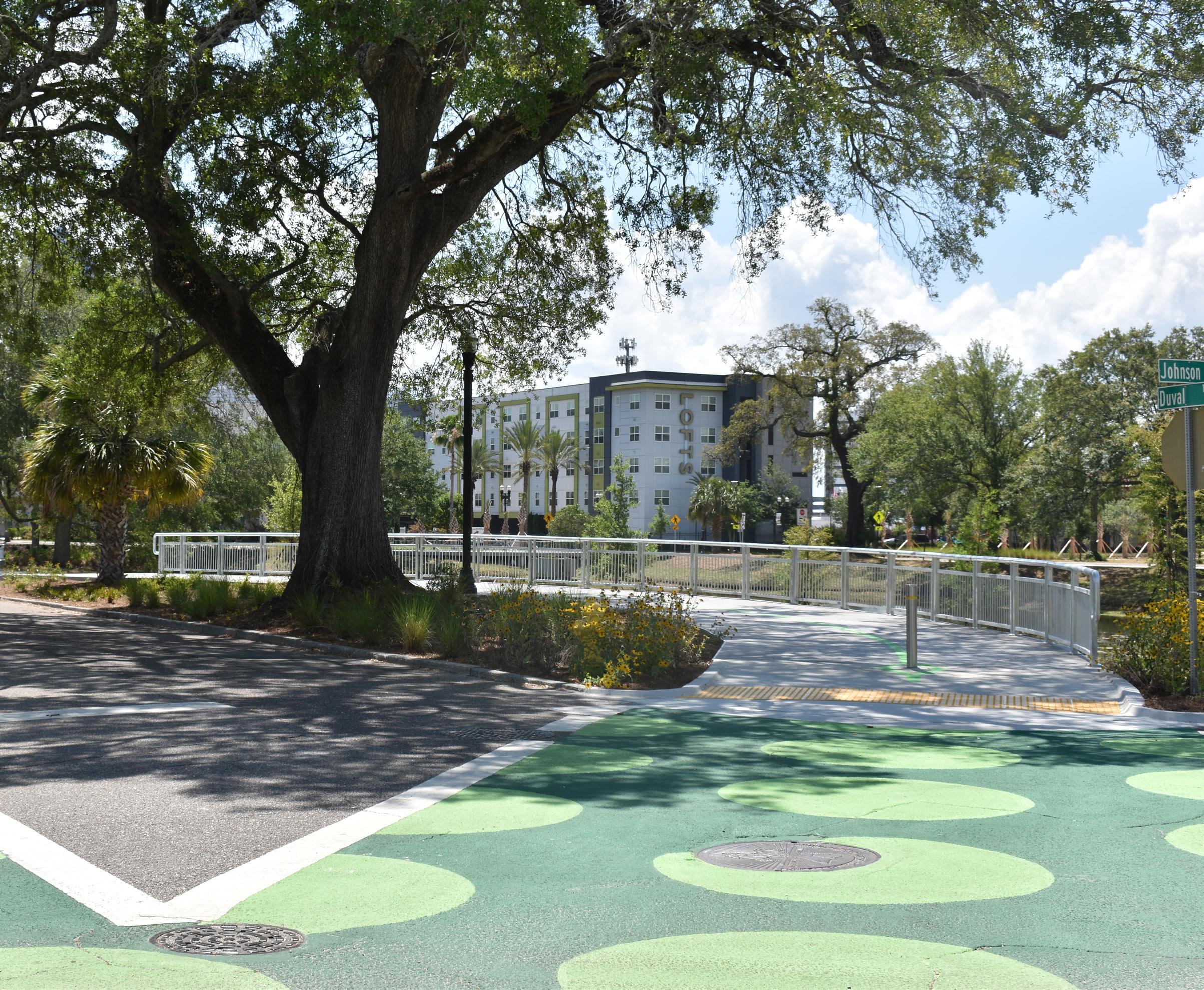
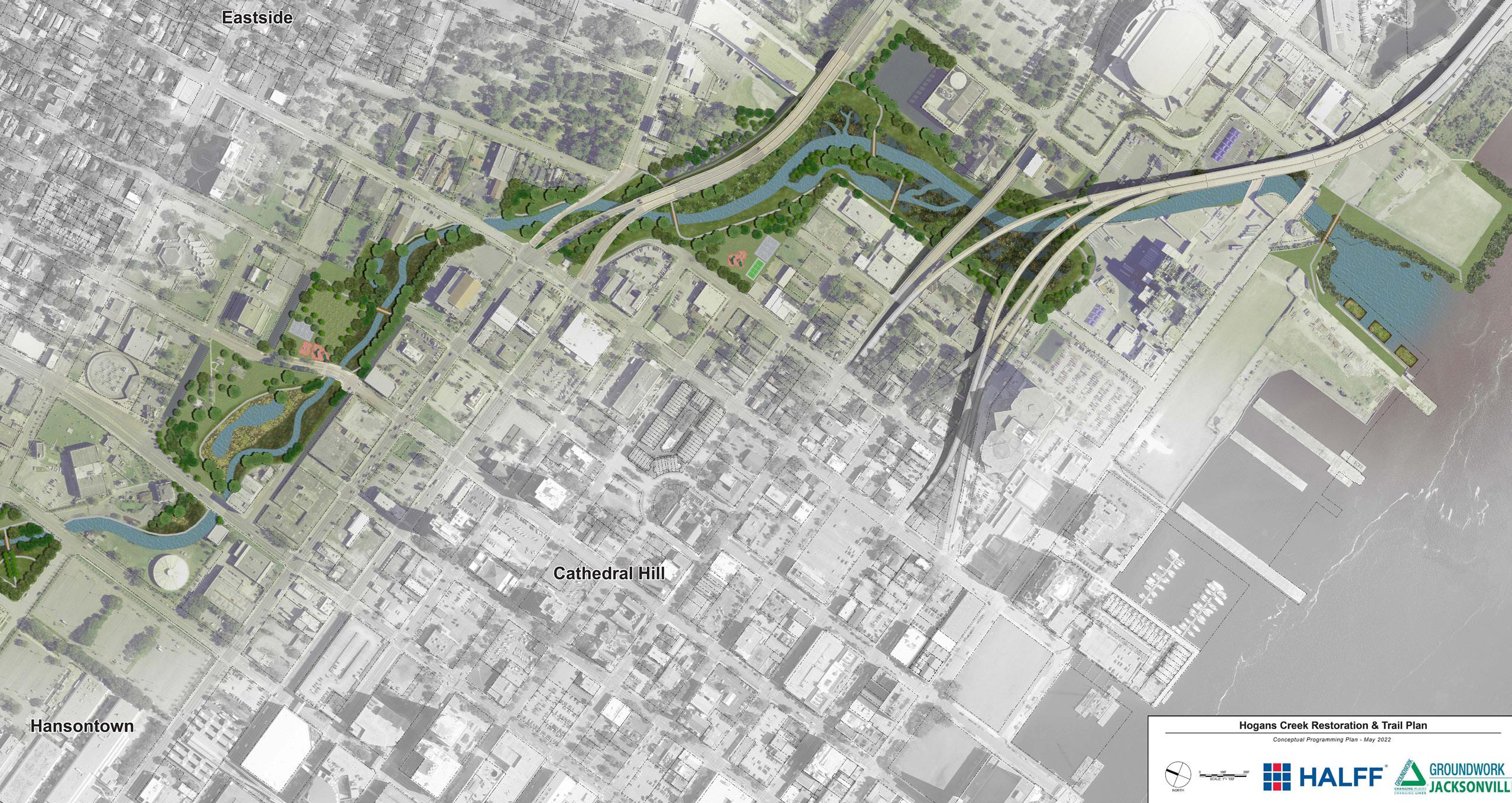

Some of the connected communities are lowerincome, minority neighborhoods that have been overlooked by the city and its plans, while others had developed a sense of mistrust from the government that Groundwork Jacksonville is trying to earn back with its programs.
“It’s one of the biggest goals of this grant –reconnecting neighborhoods that were cut off by transportation infrastructure decisions implemented years ago,” Jacksonville Mayor Donna Deegan said at a May press conference. “Schools, jobs, medical offices, places of worship – they’ll soon be more accessible for those neighborhoods that have been left behind.
“It’s one of the ways we’re making good on the broken promises of consolidation.”
Accessibility is an important piece of the Emerald Trail. One in four residents living in Jacksonville’s urban core does not have access to a vehicle, according to Ehas. The completed project would connect these citizens to 30 square miles of the city.
Additionally, for every dollar spent on trails, direct medical costs decrease by three dollars, Ehas said. Some of the urban core hosts the city’s least healthy areas, and once completed, these residents will have direct access to recreation and trail segments.
Property values on the trail are expected to increase by 6% on average, and with increased foot traffic and eyes around the trail, safety increases, too.
“Our vision is that the urban core is this vibrant place where everyone wants to live,” Ehas said. “Trails have been proven to add economic impact, and we’ve already seen that.”
One question Groundwork Jacksonville found an answer to came with the upkeep of the new trail segments. Jacksonville’s recreation department services the largest square mileage in the country. Through a series of partnerships, Groundwork Jacksonville created the Emerald Trail Stewards program, which will train and employ people from the neighborhoods to landscape and keep up the trails.
What started as a decades-old dream, the Emerald Trail is paving a way for new opportunities across Jacksonville. From citizens to Stewards to local government, Groundwork Jacksonville has been pleased with the buy-in from stakeholders in all forms.
“It’s pretty amazing how everyone has been really, really cooperative,” Ehas said. “Most people understand this is a transformational project.”



FLORIDA ENGINEERING SOCIETY

Cowan, Jr. PE., ENV SP
David Cowan, Jr., P.E., ENV SP, is a senior engineer at CMA in the West Palm Beach office. David has over 15 years of experience and holds a bachelor's and master's degree in civil engineering with a water resource focus. David serves as a Regional VP for FES, District Director for TBP, on the Urban Drainage Standards Committee, and the Chair for Sustainable Stormwater Infrastructure Committee for EWRI.

Connection with others is part of the human experience. Although it can seem intimidating, connecting with others plays an important role in our growth not only as individuals, but also within our careers.
My start in the engineering field came when I attended an American Society of Civil Engineers (ASCE) luncheon in pursuit of simply meeting engineers. After a few introductions, I asked one of the engineers if she knew of any opportunities in the area. She connected me with David. Since then, the relationship that David and I developed over the years has benefited us in many ways. Through strategic investments in social capital, active networking and committed volunteering, we can create vibrant and inclusive spaces that nurture diversity and drive progress. By understanding and using the resources and relationships within our communities, we can collectively address challenges, celebrate achievements and pave the way for future generations.
Social capital refers to the networks, relationships and norms that shape the value of a society's social interactions. It is spent through personal interactions where trust, mutual agreements and shared values facilitate cooperative behavior.
Creating and spending social capital wisely involves building and maintaining trustworthy relationships. It fosters community and collective problem-solving, which is crucial for addressing complex societal challenges. Effectively building social capital requires time and effort to nurture genuine connections and engage in community

Bradley Brown P.E.
Bradley Brown, P.E. is a water/wastewater engineer at AECOM in D.C. Metro Area. Bradley has a background in environmental engineering, focusing on water and wastewater design. Earlier in his career, he worked in South Florida, while serving as the webmaster and community service co-chair for FES Palm Beach Chapter.
activities. It enhances personal and professional growth, providing a supportive environment for innovation and collaboration. Throughout the journey, it is important to build our network and share this value with the next generation.
Effective networking involves knowing and using the resources you have, which means utilizing your current connections to gain new insight, including opportunities. Fostering existing relationships is crucial as they provide support systems, stability and collaboration opportunities.
As we grow in our careers, the need to find new and diverse talent broadens our perspective and introduces innovative ideas and viewpoints. This is critical in adapting to this rapidly changing world.
Most of the time, networking includes participating in industry events, conferences and online forums, which can expand your professional circle and open doors to new opportunities. Building a strong personal brand, on and offline, through consistent engagement and adding value to these networks is essential.
When we attend these events, we need to maintain our relationships but also grow new and diverse ones. Look for the person in the corner struggling to find a way into a conversation. Look for a person who is different from you in some way and strike up a conversation. We all have some short-term plans, vacations, trips or other personal events on which we can find common ground.
Mentoring is vital when it comes to networking, facilitating mutual growth and knowledge exchange. It helps career
advancement and personal development by gaining insights from experienced professionals, guiding emerging talent, and sharing new prospects.
The engineering profession has historically been dominated by men and non-minorities, with little change over the past 40 years. White men still make up about 75% of the engineering workforce, according to the U.S. Department of Labor and Statistics.
This disparity in engineering often results from systemic barriers such as unconscious bias and limited support networks. Addressing these barriers is crucial for creating an inclusive environment that encourages diverse participation.
Promoting diversity in engineering can be achieved through targeted recruitment starting at an early age through STEM outreach programs. Support systems throughout the education process can ensure that no unnecessary barriers exist for women and minorities as they earn their STEM degrees.
As leaders in organizations, we need a conscious effort to be more equitable in our talent recruitment and profession and to enhance the overall quality of engineering solutions.
To thrive in a global economy, the next generation of engineers must embrace diversity in people and ideas. Diverse teams bring unique perspectives and creative solutions, which are essential for tackling complex problems and driving progress in engineering. Encouraging diverse educational backgrounds and interdisciplinary approaches enriches the engineering profession. It leads to innovative solutions by integrating different methodologies and knowledge bases.
Mentorship programs and inclusive educational initiatives can nurture diverse talent early, ensuring a steady pipeline of skilled engineers from different backgrounds. These programs provide guidance, resources and inspiration for underrepresented groups to pursue engineering careers.
Volunteering in K-12 outreach programs helps inspire and educate the next generation of engineers. Participating in initiatives like Habitat for Humanity or Sleep in Heavenly Peace allows engineers to give back to the community while highlighting the impact of engineering skills. Engaging in local and state STEM activities and career days promotes the engineering profession and encourages young students or all groups to pursue careers in this field.
Volunteering also strengthens community ties and builds social capital, reinforcing the value of collaborative efforts. It provides opportunities for professional development and personal fulfillment through meaningful contributions.
Corporate volunteering programs can enhance employee engagement and satisfaction, fostering a culture of social responsibility within engineering firms. When engaged by all levels of the company, these programs benefit communities and promote the company's commitment to where we work.
The Florida Engineering Society (FES) supports the engineering community through initiatives like the Florida Engineering Foundation (FEF) Scholarships, which financially assist aspiring engineers. FES also organizes MATHCOUNTS®, a competition that fosters mathematical skills among middle school students, preparing them for future engineering challenges.
Through professional development programs, conferences and local chapter events offered by FES, engineers stay current with industry trends and find opportunities to network, mentor and give back to the community. Together, we can build a stronger, more diverse engineering profession.

Investing in social capital, actively networking with new people, addressing the lack of diversity, and volunteering our time and expertise pave a path to connect the past, future and our communities. Let's support FES and its initiatives and work collectively to inspire and develop the next generation of engineers. To learn more, visit www.fleng.org.
STRUCTURES SPECIALISTS SERVE STATE, NATION DURING DISASTERS
By Thomas Ehlers, Staff Writer
All


Sullivan’s work has brought him all over the country and even world, but most of the calls he’s received as Florida Task-Force 1’s structures specialist (StS) aren’t positive. They come after natural or man-made disasters, including earthquakes, hurricanes or building collapses, and he’s stayed ready to help rescuers’ efforts on the ground.
As a member of Urban Search and Rescue (US&R) task force, Sullivan earned a U.S. State Department USAID citation for his work during the 1999 İzmit-Kocaeli earthquake. As he’s watched the industry shift and change, he’s seen some things during his numerous deployments.
“You go in there with a humble attitude because nature is going to
“You go in there with a humble attitude because nature is going to humble you. Murphy’s Law is going to govern.”
— ROB SULLIVAN Florida Task-Force 1’s StS




These response groups ensure the continuous operation of critical government and business functions vital to human health and safety, or economic security, and there are different levels of these teams. The Sunshine State holds some of the nation’s premiere task forces – US&R groups – and StSs.
A member of a multidisciplinary team, every StS plays an important role in assessing structural damages after deployment to a disaster area, identifying hazards and recommending specific mitigations to minimize risks and ensure safety.
Structures specialists are engineers with normal jobs who wait until disaster strikes for deployment, and these special engineers play an integral role in disaster response. These individuals might not garner attention, but their services are essential to safety and society.
Two early US&R teams – Miami-Dade FireRescue and a California crew – developed methodologies and best practices to improve the field.
Both crews traveled to Mexico City in 1985 when an 8.0 magnitude earthquake rocked the region, causing nearly $5 billion in damage. During their deployment, these teams managed to save 102 lives through their efforts, but they lost 105 rescuers and responders who entered these unstable structures. It led to an effort to develop a sense of order and methodology to rescue teams.
“They said, ‘Well we need to do something about this, we need to learn how to do this because it is beyond our firefighting capabilities,’” said Sullivan.“Over a period of time, they developed a special team.”
Today, Florida has eight US&R teams – two federal teams including Florida TF-1 and TF-2 along with six other state task forces, TF-3 through TF-8. These teams consist of firefighters with varying certifications, medical specialists, canine groups and other specialized individuals.
they’ve garnered a host of other roles.
When US&R teams are mobilized, they rely on StSs to determine if bridges are safe to cross, buildings are safe to enter or other structures are passable for reaching entrapped individuals. These decisions are made quickly, a distinct difference from decisions made by traditional engineers.

Events like Hurricane Andrew in 1992 allowed US&R teams and StSs to become change agents. After the quickmoving, high velocity storm brought down a number of structures, a committee consisting of StS engineers reevaluated the South Florida building code to address wind load failures and other issues, amendments that would merge into the state’s standard building code half a decade later.
Traditionally, both federal and state structures specialists have been used to shore structures to help US&R teams safely reach victims of disasters, but through the years,
“That’s one of the more challenging things for a structural engineer to get used to,” said Andy Schrader, lead sTs engineer for the state of Florida’s US&R Task Forces and founder of Recon Response Engineering in St. Petersburg. “In our practice, we’re used to having days if not weeks to analyze a structure and make a decision. Disaster engineering is exactly the opposite – now we are forced to make decisions with incomplete, possibly incorrect information.”
Risk mitigation is the focal point of StS work. Firefighters and other medical personnel tend to work with pace, wanting to venture into structures from the onset, but structures specialists are there to give a quick evaluation of the worst possible scenarios – and provide guidance to avoid them. StSs know the other US&R group members will be going in whether they give input or not, so it’s up to them to give them the safest way possible.





“You’re not going to get it 100% right, but the best you can do is not get it 100% wrong,” said Jonathan Milton, Florida StS of TF-4 and president of Milton Engineering Consultants. “Really, that’s the framework that we are working with – we have to make decisions in a very short duration because you have a lot of people waiting on you to move forward. What it comes down to is the training.”
Structures specialists can complete two certificates, including a StS1 and StS2. Before earning an StS1 distinction, individuals must be a licensed professional engineer and be practicing structural engineering. The initial certification can be earned through a week-long training program. The StS2 is an advanced certification, reflecting an additional week of more elaborate training.
The U.S. Army Corps of Engineers hosts these certification courses, and individuals can earn other distinctions, including Heavy Equipment & Rigging Specialist. A look at the job description of an StS can be daunting – nearly two dozen suggested or required training courses and a roles and responsibilities list just as long.
An StS’s day job is one way to practice these skills, as the typical tasks of an engineer can give ample experience. For Schrader, the best training comes in complex training situations with paramedics where an StS can test their common sense and critical thinking skills, including car crashes resulting in a building collapse or complicated vehicle accidents with entrapment.

“You’re not going to get it 100% right, but the best you can do is not get it 100% wrong,”
— JONATHAN MILTO N Florida StS of TF- 4
“A lot of times the biggest challenge is not so much the technical expertise but the mindset,” Schrader said. “Ninety-nine percent of the time, we’re just normal structural engineers doing our day job, whereas the firefighters or rescue teams are 180-degrees the other way around. It’s not an easy place, mentally, for most engineers to get into.”
Another difficult part of the job is the mental and emotional strain that these high-stress and often scarring situations cause. With disasters, there are high probabilities of seeing the deceased, badly injured or other disturbing images.
“At the time, you have to compartmentalize,” Schrader said. “You have to just stow this stuff away, accepting that sometime in the future you will have to unpack and it won’t be fun. You may well need some form of mental health therapy to help you unpack later on what you are seeing and understand the significance of what you are seeing.
“I personally focus much more on what is the actual goal, what I am doing there, and I intentionally avoid thinking too hard about what is under this pile.”
Other dangers exist in emergency situations. Hurricanes bring flooding and downed power lines, leading to electrocution risk. Helicopters used in rescue operations can crash. Staying awake for dozens of hours to monitor structures can be taxing, both mentally and physically. But structures specialists can count on dealing with these factors every deployment.
“Doing this type of work takes a very specific person,” Milton said. “There are certain people that run toward danger, and there are certain people that run away from danger. We’re the ones that run to it.”
And this trio has made a sprint to some of the state and world’s worst disasters. Sullivan made a call to use a series of airbags instead of a crane during the 2018 Florida International University pedestrian bridge collapse. Schrader and Milton were deployed to Champlain Towers South after its 2021 collapse in Surfside, the third-biggest
Much like how the federal framework exists to share assets, the state of Florida’s US&R teams rely heavily on one another.
“The structured specialists in the state of Florida are a pretty close-knit group of individuals,” Milton said. “We share information; we bounce stuff off of each other; we rely on each other. I think that’s pretty important because when you get in certain situations, you might necessarily have the particular expertise and background to look at something. There are people within our organization that you could reach out to and figure out that information.”
In Shrader’s role, he coordinates structures specialists assets for state task forces 3 through 8, most recently sharing best practices and lessons learned from Hurricane Debby, the region’s latest natural disaster. Cell phone numbers and email addresses are the most important credentials for US&R groups, both to coordinate StS availability and assets when disasters strike.
As essential as structures specialists are to US&R groups, the actual number of these credentialed engineers is fewer than one could realize. Two of the state task forces don’t have structures specialists tied to their units, but this trio is seeking to change that.
On top of recruitment presentations, Milton spearheaded an effort to ensure liability coverage for StSs and US&R teams deployed during disasters. Florida statute 768.382 went into effect in July 2021, and it protects engineers, architects and structures specialists voluntarily participating in emergency response activities from being liable for any personal injury, wrongful death, property damage, or other economic loss. Editor's note: Read more about FS 768.382 in our Law & Ethics feature on page 8.
“We don’t want to react to an engineer getting sued because the decision he made wasn’t the best decision and there was a bad result of that,” Milton said of the statute, ironically signed a week after the Surfside collapse. “By getting the Florida legislature to acknowledge that and put it in place was a big win for engineers in the state of Florida.”

There are other challenges to recruitment. Structures specialists – and perhaps more importantly, their employers – must be ready to leave the office for up to 14 days of deployment, which can affect projects. Although these positions are paid, there are no inflated salaries. Despite these obstacles, these three engineers hope to find the newest young talent to answer one of a civilian’s hardest calls.
“There’s no great glory or pay attached to this job,” Schrader said. “You do this job because you care about serving the firefighters and personnel that you go there for and try your best to keep them alive.”
To learn more about working with a US&R task force near you, visit fema.gov/emergency-managers/ national-preparedness/frameworks/urban-searchrescue.





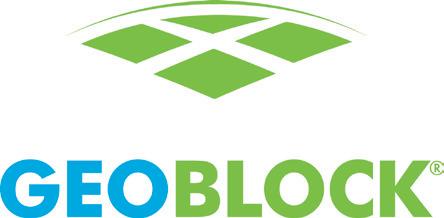





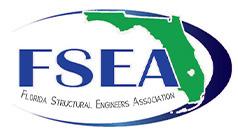

Andrew Lovenstein, PE, SI
This article was reprinted from the April 2024 issue of Structure magazine with permission from its publisher. For more information, visit www.structuremag.org State Board Member of the FSEA.
The sense of community we experience as engineers is one of many things I enjoy about our profession. Part of being in our community experience is a responsibility we have to give back, to use our skills to the greater good. This responsibility manifests itself in different ways. We share our collaborative knowledge to strengthen building codes and industry standards. We continue our education to stay current in our profession so that we can advance the communities around us.
There is another way we give back – one that I have found particularly rewarding – and that is helping our larger community through disaster response. The know how we carry as engineers can greatly help in many disaster situations.
Disaster response is wide-reaching, so let’s focus today on two avenues I have been active in for many years: Structural Engineers Emergency Response (SEER) and Urban Search and Rescue (US&R).
When a natural disaster impacts a large area, such as hurricanes striking Florida, a wide swath of structures can become damaged. City or county building departments, as well as state or regional Emergency Operations Centers must check these buildings to make sure they are safe and habitable or if they have to be evacuated until repairs are made.
SEER volunteers make a quick evaluation of the homes or commercial structures, notify the owners of the building’s status, and provide that status to local building departments. A volunteer does not have to be a Professional Engineer, but PEs are greatly appreciated.
To join a SEER team near you, you must first take one of two classes on how to evaluate structures:
• When Disaster Strikes, presented by The International Code Council (ICC)
• California Office of Emergency Services’ Safety Assessment Program
These classes are offered several times a year by industry groups, including FSEA. Additionally, the National Council of Structural Engineers Associations (NCSEA) offers training through its CalOES Safety Assessment Program, which is compliant with the requirements of the Federal Resource Typing Standards for engineer emergency responders.
After taking one of these classes, volunteers can sign up to be placed in the Disaster Response Alliance. This single, national database of skilled volunteers willing to help with response and recovery activities was created by the ICC and NCSEA. It’s located at the Disaster Response Alliance website, www.disasterresponse.org.
After a natural disaster, area building departments and/or emergency operation centers will determine how many SEER volunteers will be needed and reach out to the Disaster Response Alliance to review the database of volunteers. After the volunteer has been contacted and agreed to be deployed, they will travel to the area of the natural disaster and work with the local officials to evaluate the buildings. Typical deployment occurs a couple weeks after the natural disaster for a week or two.
The inspection plan and locations will be provided to the volunteers by the local Authority Having Jurisdiction (AHJ). Volunteers conduct their inspections on the designated structures and report their data back to the AHJ each day.
US&R teams deploy to affected areas right after natural disasters, as well as after a building collapses. While these teams are organized by individual states, some state teams are also designated to be Federal Government FEMA teams.


US&R teams are typically made up of firefighters who conduct rescue operations, alongside structural specialists who assist the rescuers. Other specialists on a US&R team include medical doctors, rescue dog handlers, experts in crane lifting, and drone pilots.
Structural specialists evaluate damaged buildings and monitor them while rescue efforts are underway, providing advice on shoring damaged elements of the structure so that the rescuers are in the safest conditions possible. Unlike with SEER, these volunteers must be professional engineers with experience in buildings, construction and building evaluations.
To volunteer, contact the lead structural specialist – every US&R team has one – and express interest in joining the team. After joining, the volunteer will be sent to Structural Specialist Training conducted by the U.S. Army Corps of Engineers. This week-long class focuses on using building monitoring equipment, shoring techniques and guidelines, and hands-on experience in conducting building evaluations and search operations.
After a natural disaster or building collapse – or even before in the case of a hurricane – states and FEMA will activate the US&R teams. The structural specialists deploy with the rescue teams to conduct search and rescue operations.
When a US&R team is activated, the team and all its gear are loaded onto transportation and sent to the affected area for a deployment that can last between one and a few weeks.
I can attest that volunteering is rewarding both on a professional and personal level. After all, disasters happen, and we as engineers are uniquely qualified to help save additional lives and infrastructure by ensuring rescue and recovery efforts are performed safely.

EDUCATION UPDATE:
All Professional Engineers licensed in Florida must report their continuing education to renew their licenses during the upcoming renewal period.
Florida Statutes required this change because the percentage of PEs failing the random CE audit was too high for two consecutive renewal periods.
To renew your PE license for another two years, you must complete 18 hours of continuing education by Feb. 28, 2025. Of the 18 hours, one hour must relate to the Florida laws and rules of Professional Engineers from a Board-approved provider, and one hour must relate to professional ethics. Four hours must relate to an area of practice. The remaining 12 hours may be related to any topic pertinent to the practice of engineering.
Only the Florida laws and rules course will be reported directly by the CE provider; you must report the other 17 hours using the free NCEES CPC Tracking system, which can be accessed at ncees.org/ncees-services/cpctracking. We also have step-by-step instructions on our website (fbpe.org) that will help you set up a free NCEES account and begin uploading your CE documentation.
As you complete your CE courses, start uploading your documents to your NCEES CPC Tracking account, but do not send your CE transcript to the FBPE until after you have completed all of your continuing education courses.
Also, do not mail or email your CE documentation directly to FBPE; you must use the NCEES CPC Tracking tool. The only continuing education course that you must report directly to FBPE is the Advanced Building Code course.
FBPE will begin verifying completion of continuing education after renewal closes.
Since the Florida laws and rules course will be reported directly by CE providers, it will be the only course that will show up in your account at myfloridalicense.com. You should verify that the current course shows up in your licensure record by logging into your account at myfloridalicense.com. If it is missing, contact your course’s provider. Your PE license will not renew until the course appears in your licensure record.
The NCEES CPC Tracking system and the licensure system at myfloridalicense.com are not linked. The CE courses that you upload to NCEES CPC Tracking will not be reflected in your account at myfloridalicense.com.
If you have any questions about renewing your license, please call us at (850) 521-0500 and select “Renewal” to speak to a representative, or email renewal@fbpe.org.


Katie Batill-Bigler CPSM
Marketing Director, Patel, Greene and Associates, LLC
In an industry where success is predicated on winning the most prestigious projects, the Society for Marketing Professional Services (SMPS) stands out as a catalyst for collaboration and shared success. Florida’s SMPS chapters serve as proverbial “common ground” where engineering firms and their staff can come together— not as competitors, but as partners in the pursuit of best practices and collective achievement.
By fostering meaningful connections among marketing and business development (BD) professionals, SMPS empowers its members and leadership to grow professionally, cultivate valuable relationships, and drive forward groundbreaking infrastructure initiatives like neighborhood parks, statewide trail systems, broadband networks, and the U.S. Department of Transportation’s Reconnecting Communities Pilot Program.
One of SMPS’s core strengths is its ability to connect marketing and BD professionals across the industry. These connections are not just about expanding business opportunities; they are about building lasting relationships that drive professional development and career growth. Through its various programs and networking events, SMPS provides a platform for professionals to share insights, exchange best practices and support one another in achieving business goals. By coming together in a spirit of cooperation, members can leverage each other’s strengths to elevate their own practices.

SMPS hosts events across Florida serving consultants and clients alike in market sectors ranging from healthcare and transportation to education and water/wastewater. At the same time, workshops, seminars and panels, tailored specifically for marketing and BD staff, allow members to engage with peers, learn from industry leaders and develop essential skills. Producing dynamic proposals, providing valuable coaching for interviews and presentations, as well as managing teams, are all strengths that can be gained and leveraged by participating in SMPS programs.
The Reconnecting Communities Pilot Program (RCP) aims to address community connectivity challenges by “improving access to daily needs such as jobs, education, healthcare, food, nature and recreation, and foster equitable development and restoration, and provide technical assistance to further these goals.” Applications for the latest round of funding are due Sept. 30, and up to $607 million is available to fund projects through FY 2026. Last year, three Florida projects were awarded funding:
• A Jacksonville Transportation Authority Emerald Trail extension project, which aims to reconnect disadvantaged neighborhoods divided by Interstate 95 by building a 15mile bike and pedestrian trail with a linear park system.
• A Broward MPO project examining the feasibility of tunneling roads under the Florida East Coast Railroad,
enhancing safety and accessibility for pedestrians and cyclists while connecting a disadvantaged area to key amenities across the railroad.
• A comprehensive planning project by the Miccosukee Tribe seeks to develop a transportation network that enhances connectivity, safety and equity while addressing barriers, reducing environmental impacts and boosting economic growth.
Achieving the goals of programs like the RCP requires collaboration between engineers, planners, architects, contractors and government agencies. SMPS and its members facilitate these partnerships by bringing together diverse stakeholders, ensuring that the various expertise needed for complex projects are aligned and working towards a common objective—delivering innovative projects that meet clients’ goals and their communities’ needs.
By fostering meaningful connections among marketing and business development (BD) professionals, SMPS empowers its members and leadership to grow professionally, cultivate valuable relationships, and drive forward groundbreaking infrastructure initiatives...
Through its extensive network and deep industry knowledge, SMPS is uniquely positioned to help drive the success of the RCP and similar initiatives.
Beyond BD and marketing professionals, much of SMPS’s membership is made up of communications specialists. These individuals are fundamental in capturing the technical effort and innovation behind every infrastructure project that encourages communities to come together as well as the ultimate successes of these projects.
It is critical that firms have dedicated talent to highlight the impact these projects have—providing safe spaces to gather with friends and family, enabling easier access to public transportation, connecting underprivileged children and elders with educational and healthcare resources via the Internet—so that the public takes notice, recognizes the benefits to our society, and supports future policy and funding for future enhancement projects.
As the AEC industry evolves, the importance of collaboration and shared achievements grows more evident. SPMS offers a unique opportunity to be part of a vibrant community dedicated to connecting professionals, advancing industry initiatives and fostering collective achievement.
Whether you are a marketing professional, a BD specialist, or a firm seeking to enhance your business practices, SMPS provides the resources, network and support needed to thrive. By joining SMPS, you become part of a movement that values collaboration, innovation and community success.

2024 FES|ACEC Florida Annual Convention, July 24-27, 2024, at the JW Marriott Miami Turnberry


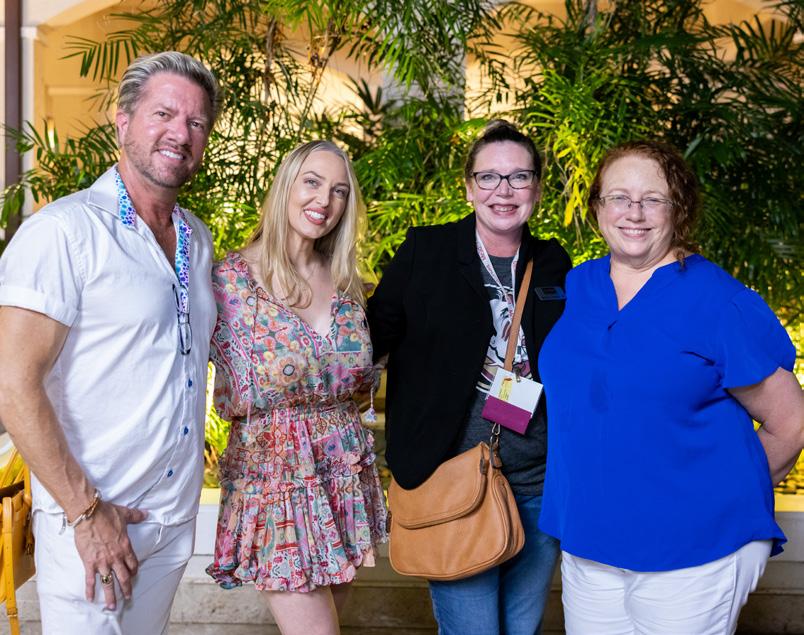




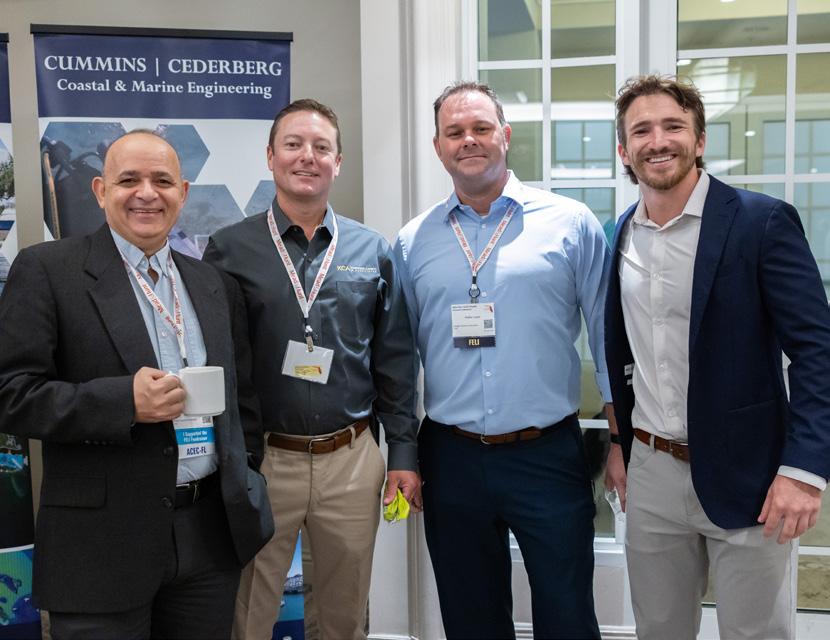

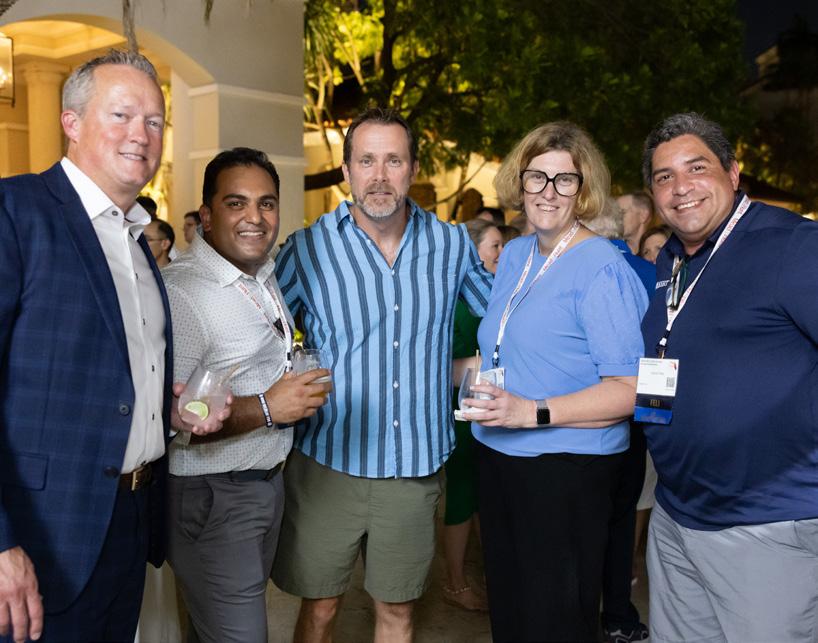




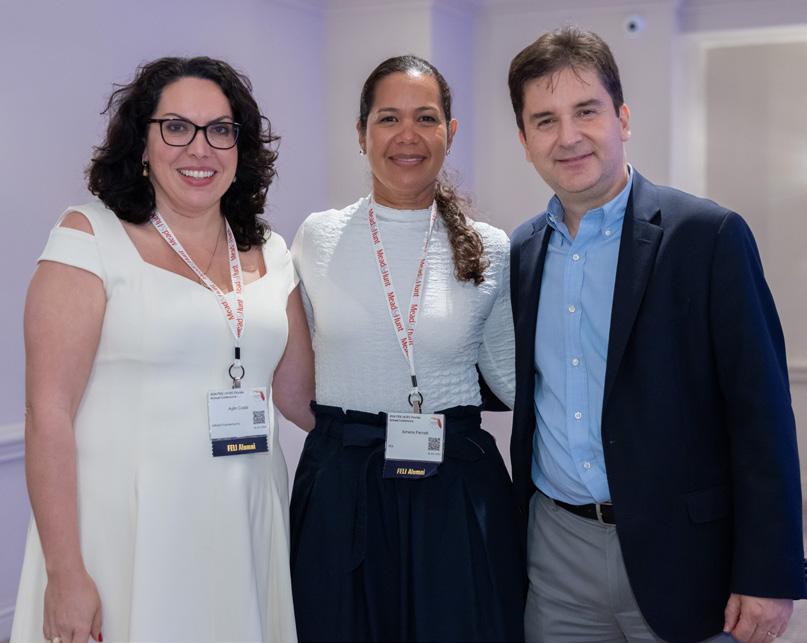







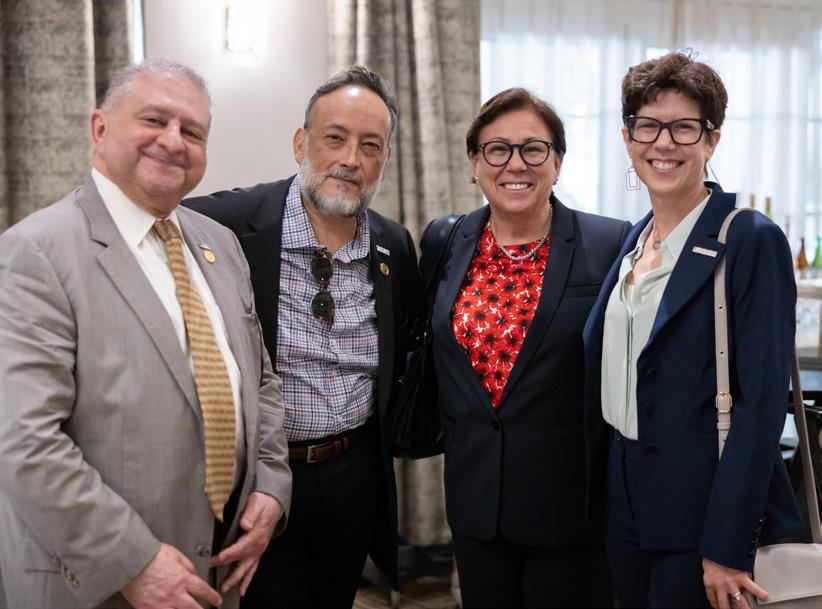

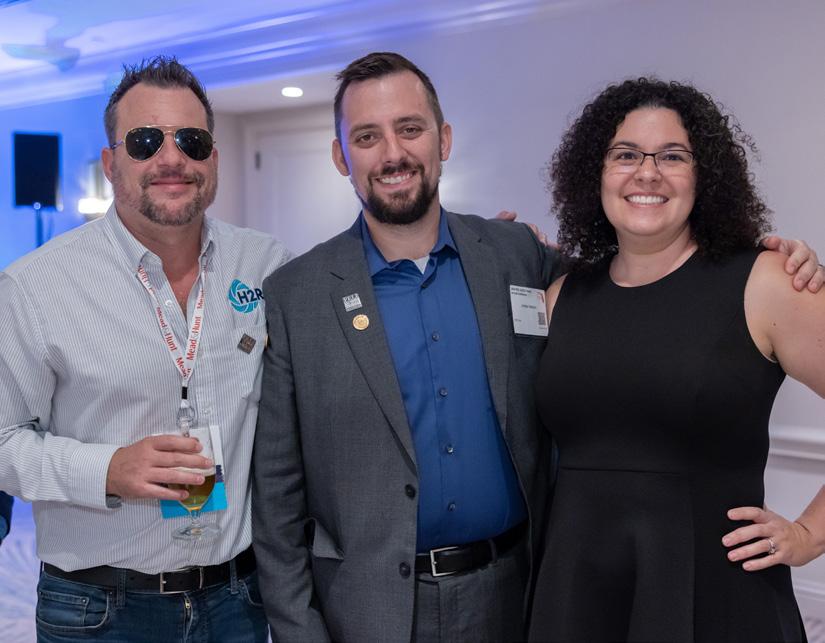



Are you looking to get your company in front of industry professionals, firm leaders, government officials, business leaders and potential clients from every part of Florida? If you are doing business anywhere in the engineering or consulting space in the Sunshine State, this is exactly the valuable audience you want to reach.
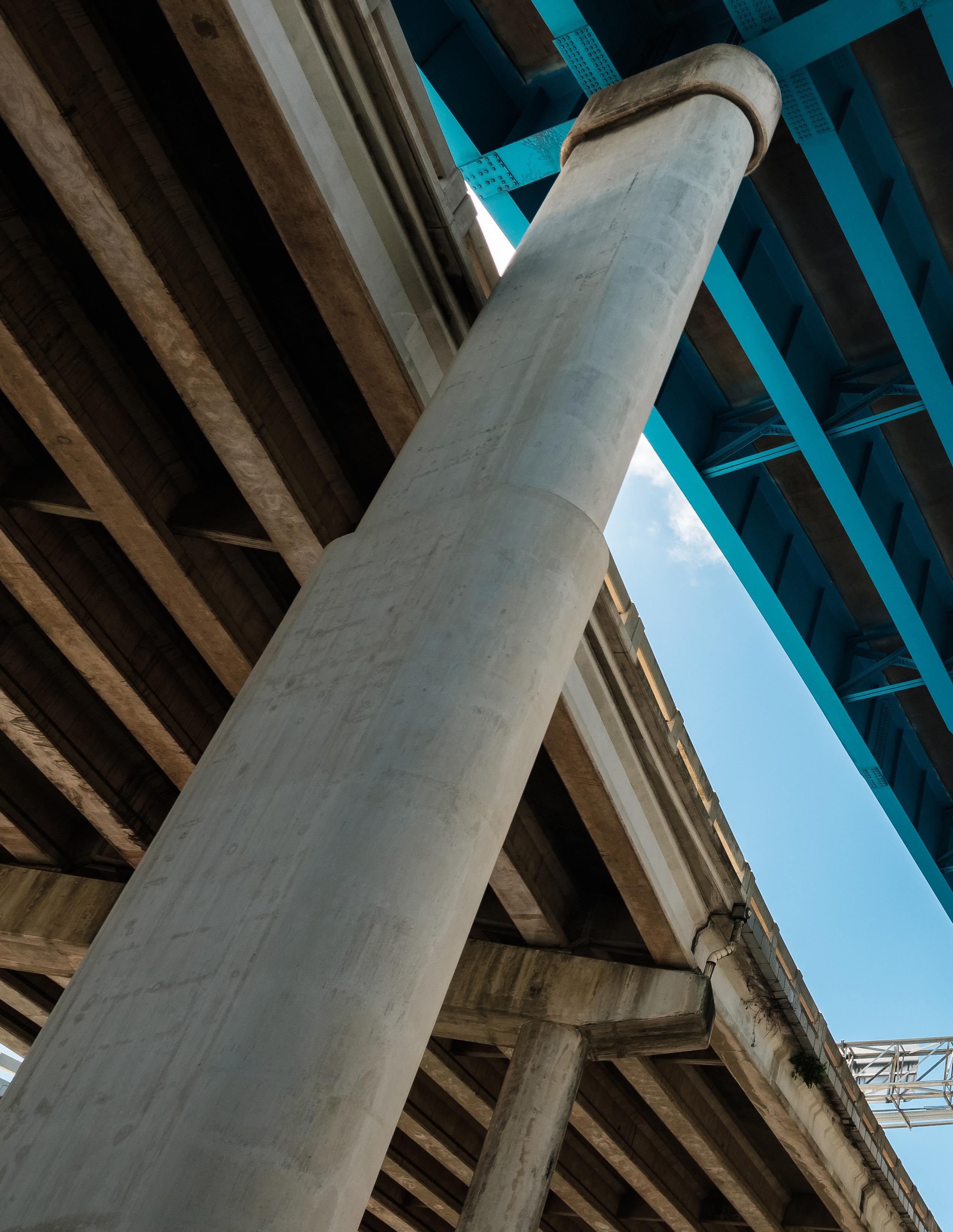
US POSTAL SERVICE STATEMENT OF OWNERSHIP MANAGEMENT AND CIRCULATION
Title of Publication................................................................................................... Engineering Florida
Publication No.................................................................................................................................277-720
Date of Filing ....................................................................................................................................... 2024
Frequency of Issue......................................................................................................................Quarterly No. of Issues Published Annually............................................................................................................4
Publisher ..............................................................................................................................Allen Douglas
Editor.......................................................................................................................................Stacey Butler
Owner ..........................................................................................................Florida Engineering Society
Engineering Florida, ISSN 0015-4032, is published quarterly as the official publication of the Florida Engineering Society. Copyright 2023. All rights reserved. FES members receive Engineering Florida as part of their membership benefits. Editorial matter, change of address, and correspondence regarding advertising should be mailed to: FES, P.O. Box 750, Tallahassee, FL 32302 or email fes@fleng.org.
Mailing Address of Office of Publication, General Business Office, Publisher: Allen Douglas, Owner:
Florida Engineering Society, P.O. Box 750, Tallahassee, FL 32302-0750
The purpose, function, and nonprofit status of this organization and the exempt status for federal income tax purposes has not changed during preceding 12 months.
• Cover Story: Top Projects of the Year
• Connective Features:
— People of the Year
— Young Professionals of the Year
— Industry Roundtable
Content Deadline: Nov. 8
Ads & Art Deadline: Nov. 22
Print Deadline: Dec. 6

For questions or more information, please contact Engineering Florida Managing Editor: Joe VanHoose at joe@trestlecollective.com. To access the media kit, scan the qr code or visit fleng.org/wp-content/ uploads/2024/06/2024_2025-Engineering-Florida-MediaKit.pdf











